Table of Contents
- Market Performance in 2024
- Bitcoin
- Analysis of the Top 10 Cryptocurrencies by Market Capitalization
- Top 10 Charts Overview: Key Conclusions & Strength Rankings
- Sector Analysis
- Blockchain Analysis
- DeFi Sector
- Prediction Markets
- Meme Coins
- Blockchain Infrastructure
- GameFi
- Blockchain Services
- NFTs
- Predictions for 2025
- The Bottom Line
Table of Contents
- Market Performance in 2024
- Bitcoin
- Analysis of the Top 10 Cryptocurrencies by Market Capitalization
- Top 10 Charts Overview: Key Conclusions & Strength Rankings
- Sector Analysis
- Blockchain Analysis
- DeFi Sector
- Prediction Markets
- Meme Coins
- Blockchain Infrastructure
- GameFi
- Blockchain Services
- NFTs
- Predictions for 2025
- The Bottom Line
The Year 2024: A Historic Milestone for Cryptocurrency
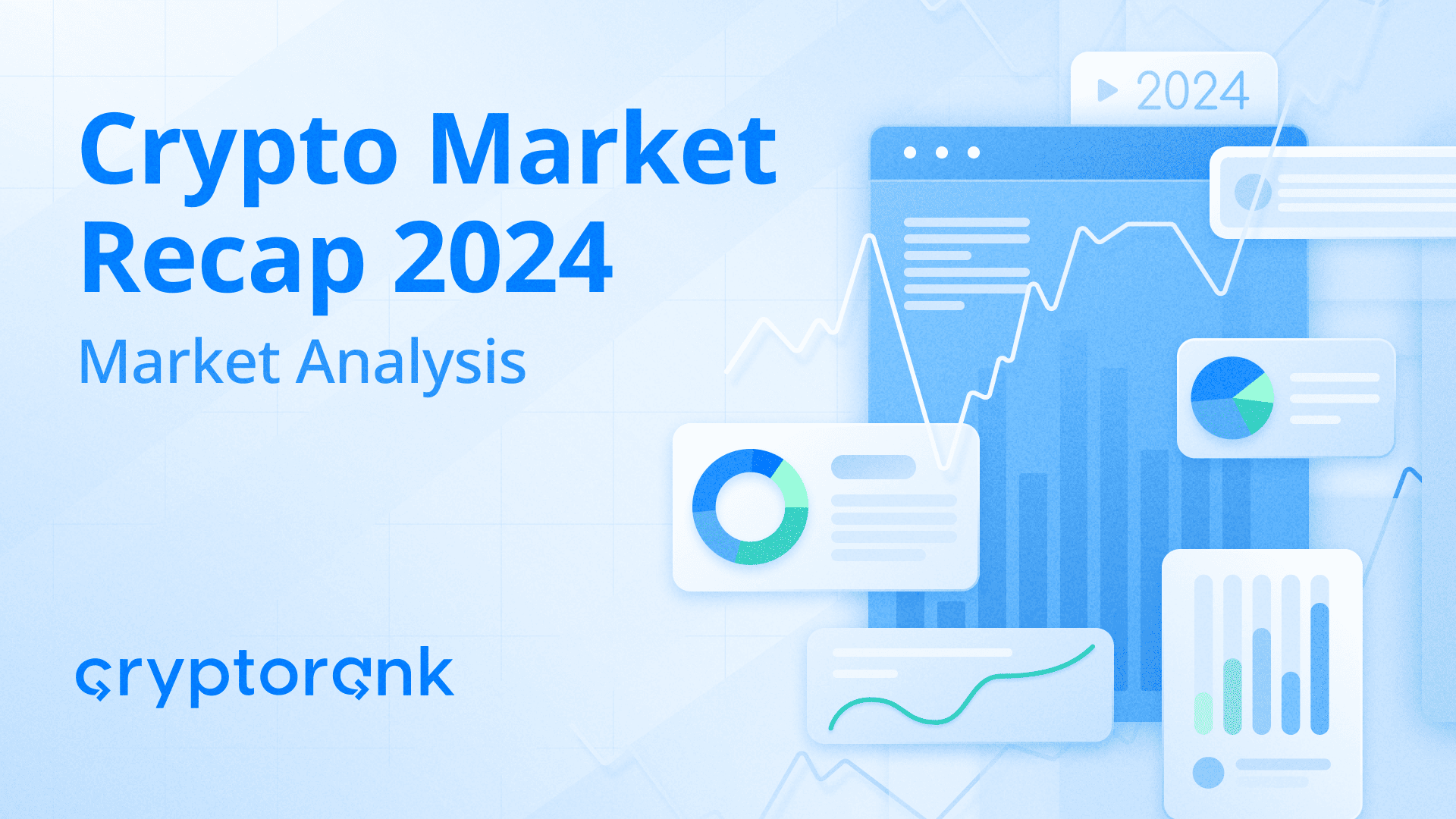

Our previous recap was mainly focused on the major events of 2024. The following annual report is a deep dive that centers on data, figures, and charts.
Market Performance in 2024
In 2024, the cryptocurrency market more than doubled in value, with total market capitalization soaring from $1.65 trillion on January 1 to $3.28 trillion by year’s end — a remarkable 98% increase. The year witnessed sharp surges in Q1 and Q4, fueled by anticipation of the Bitcoin halving and the approval of a Bitcoin ETF in Q1, as well as Donald Trump’s election victory in Q4. However, much of the year was characterized by consolidation, as investors grappled with uncertainty about the market's future outlook.
Interestingly, not all top 100 cryptocurrencies saw gains, despite the bullish year. Some assets recorded losses, particularly among layer 1/2 blockchains.

Bitcoin made up more than half of the cryptocurrency market’s growth in 2024. Its market cap jumped from $864 billion to $1.85 trillion, even surpassing the market cap of silver. Bitcoin’s dominance rose from 47.8% to 53.8%, peaking at 57.2% on November 21. This growth was largely driven by a shifting narrative among institutional players, such as BlackRock and prominent hedge funds, positioning Bitcoin not merely as a cryptocurrency but as 'digital gold.' In contrast, many altcoins underperformed, solidifying 2024 as a year where Bitcoin indisputably led the market.
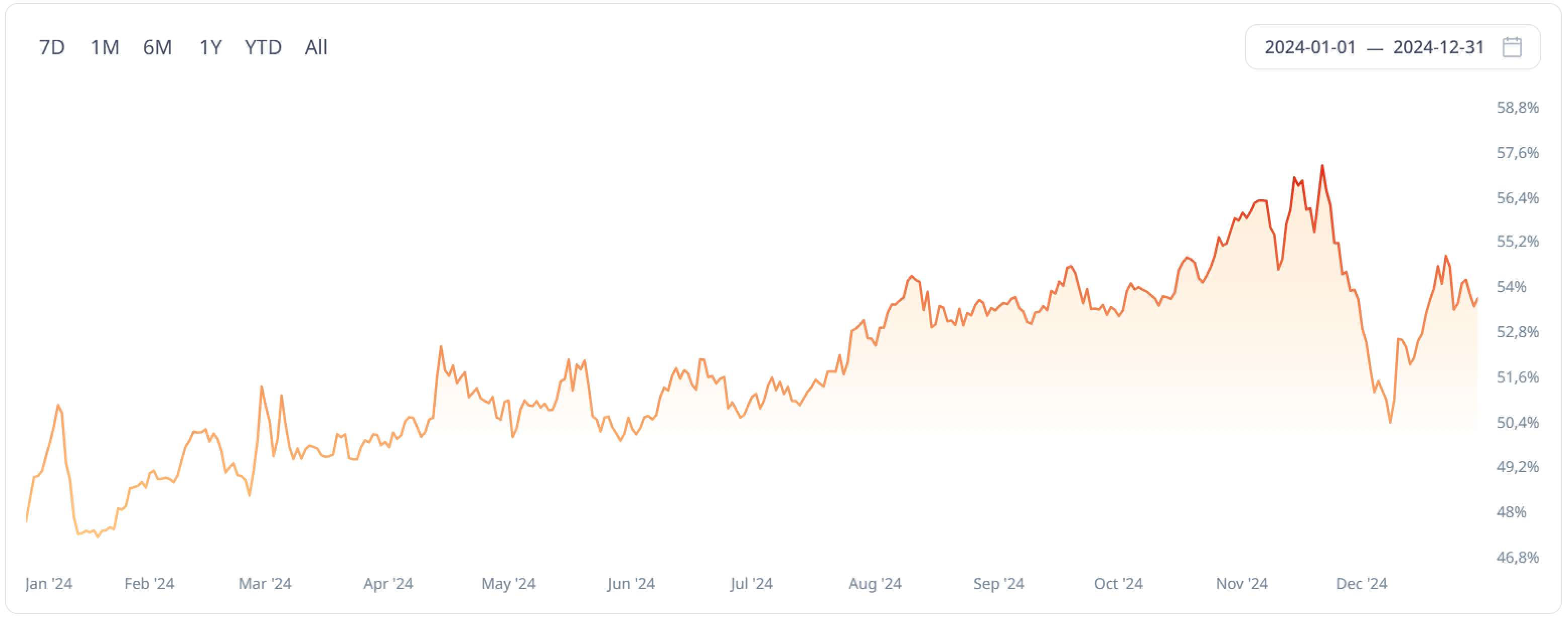
Bitcoin and Ethereum outperformed traditional assets in 2024, showing how risky assets like crypto tend to grow during economic booms. The global economy, especially in the U.S., benefited from falling inflation and lower interest rates, creating a positive environment for markets. Looking ahead to 2025, interest rates are expected to drop further, though Federal Reserve Chair Jerome Powell has warned about moving cautiously. While forecasts for 2025 remain positive, it’s worth noting that markets are already near all-time highs.
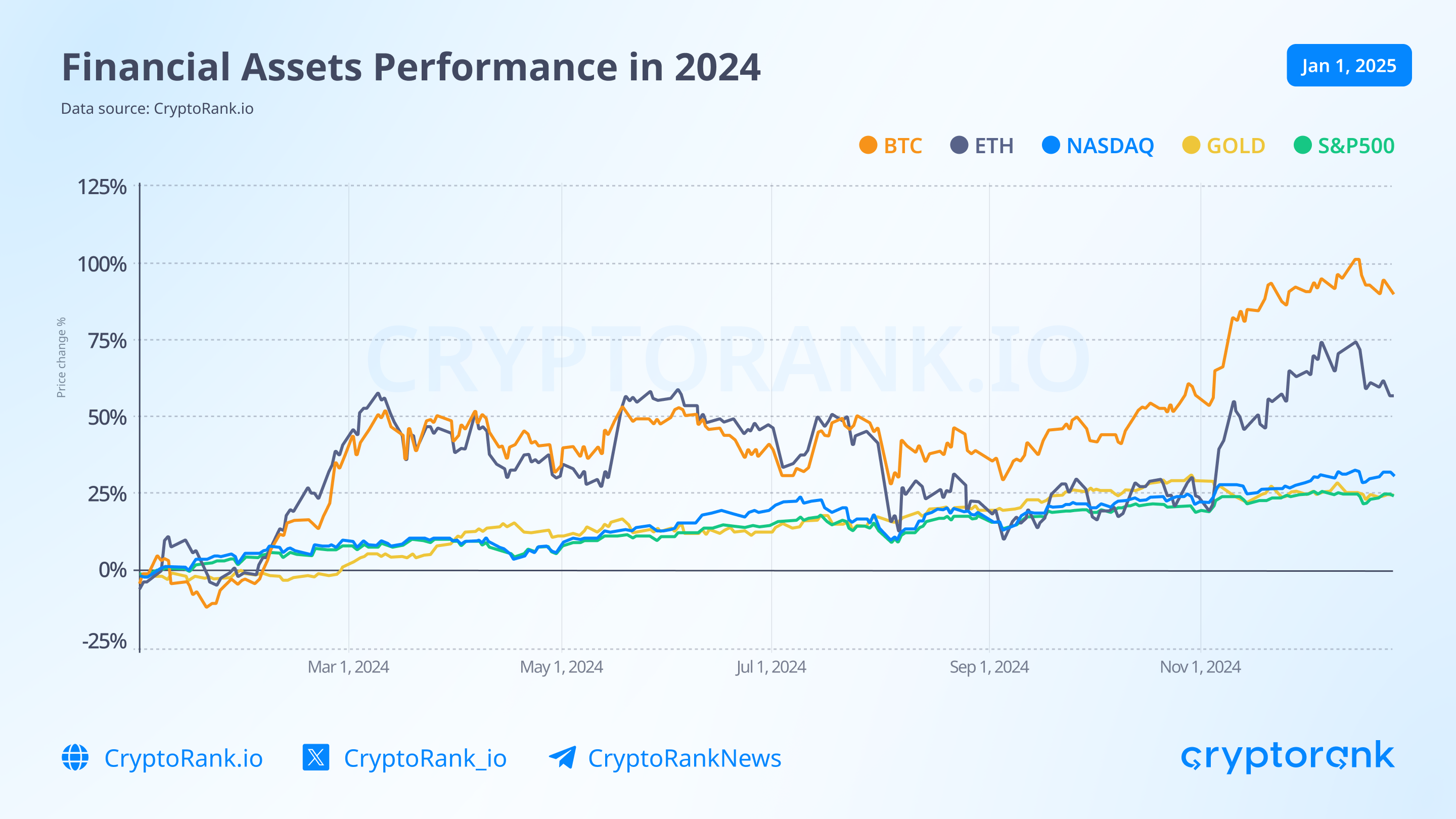
Key macro indicators reveal the market’s current state. For instance, Warren Buffett’s indicator, which measures the ratio of U.S. GDP to total market capitalization, stands at 203%. This indicates a highly overheated market, exceeding two standard deviations.
The correlation between the U.S. stock market and cryptocurrency is particularly notable, especially with Bitcoin and Ethereum ETFs now trading.
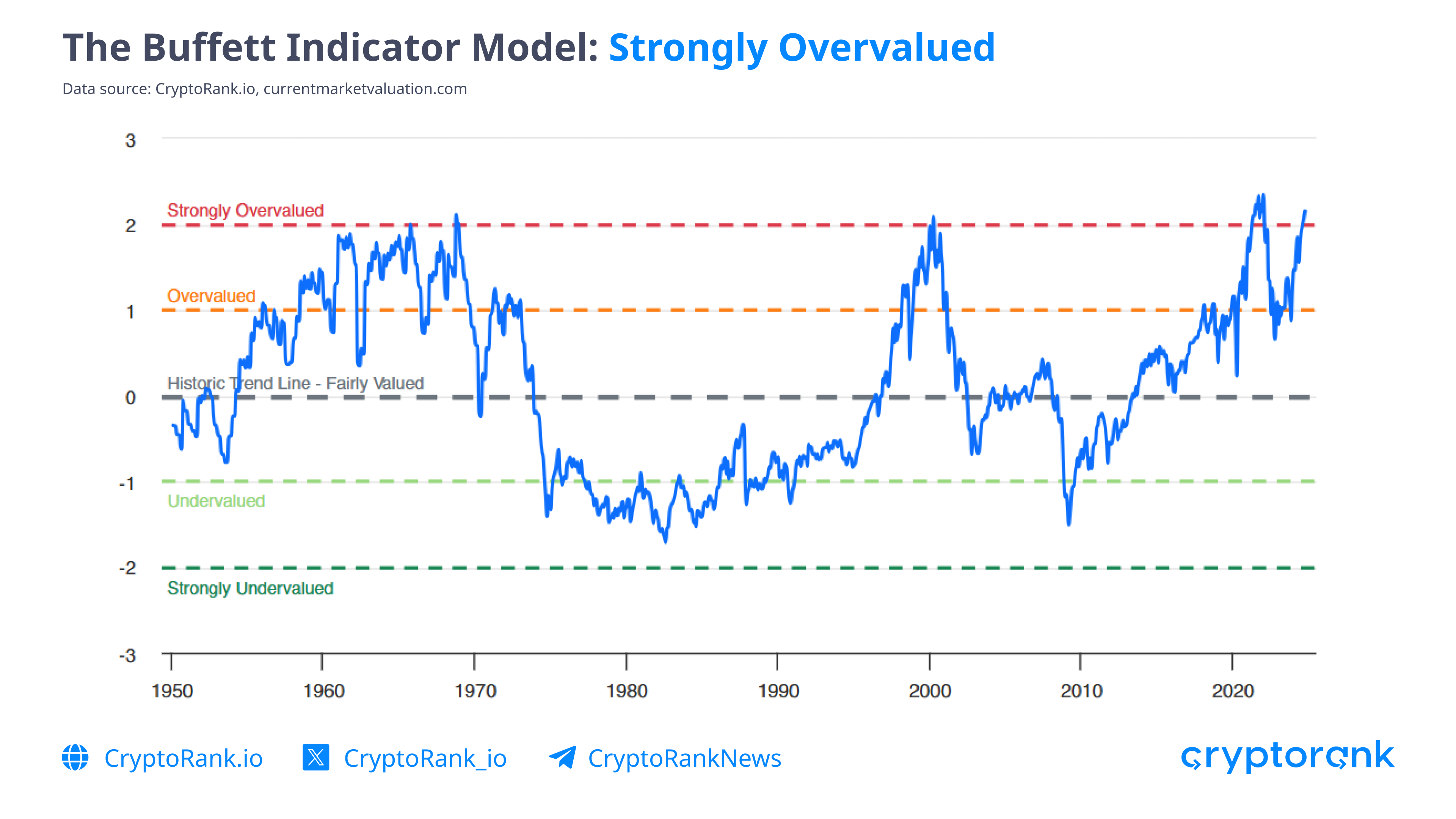
On the other hand, the famous "Crypto Rainbow Chart" indicates that Bitcoin's price is in the accumulation zone. According to the cyclical theory discussed in our previous reports, this suggests potential for further price increases.
We might indeed be in the accumulation phase. If governments and corporations start acquiring Bitcoin en masse, the U.S. government could become a key driver of Bitcoin’s price, influencing other cryptocurrencies as well.
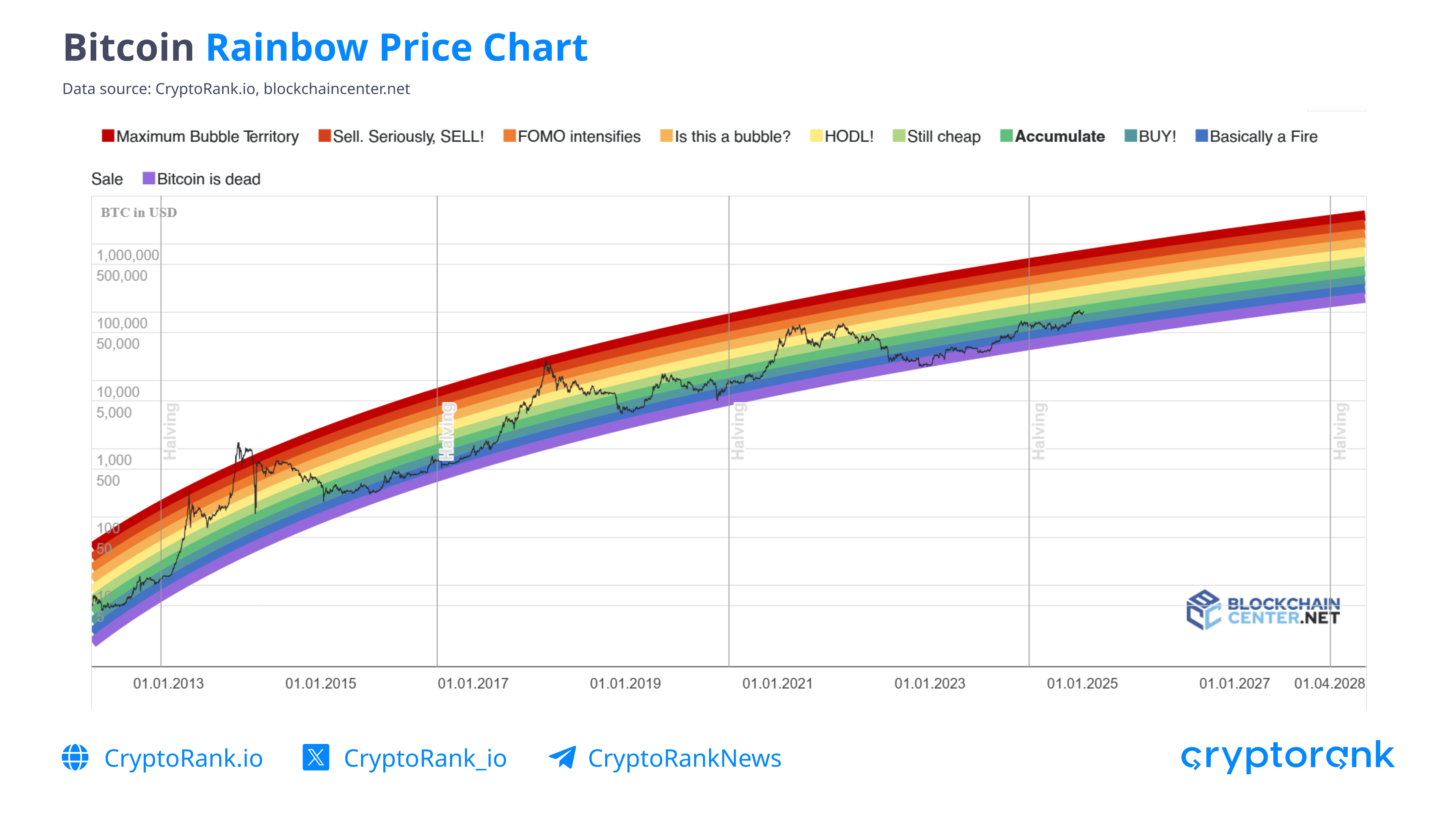
Bitcoin
The influence of U.S. politics on Bitcoin’s price became increasingly evident in 2024, as reflected in market trends. Key drivers of growth included the launch of Bitcoin ETFs (though the price surge was delayed by a month due to Grayscale's Bitcoin sell-off) and the election victory of pro-crypto candidate Donald Trump in the U.S. presidential race.
For Bitcoin's explosive growth to continue, practical steps from the U.S. government will be crucial. If policies and actions align with a pro-Bitcoin stance, further price increases can be anticipated. However, if the integration of Bitcoin and cryptocurrencies at a political level is paused or reversed, a price correction is likely.
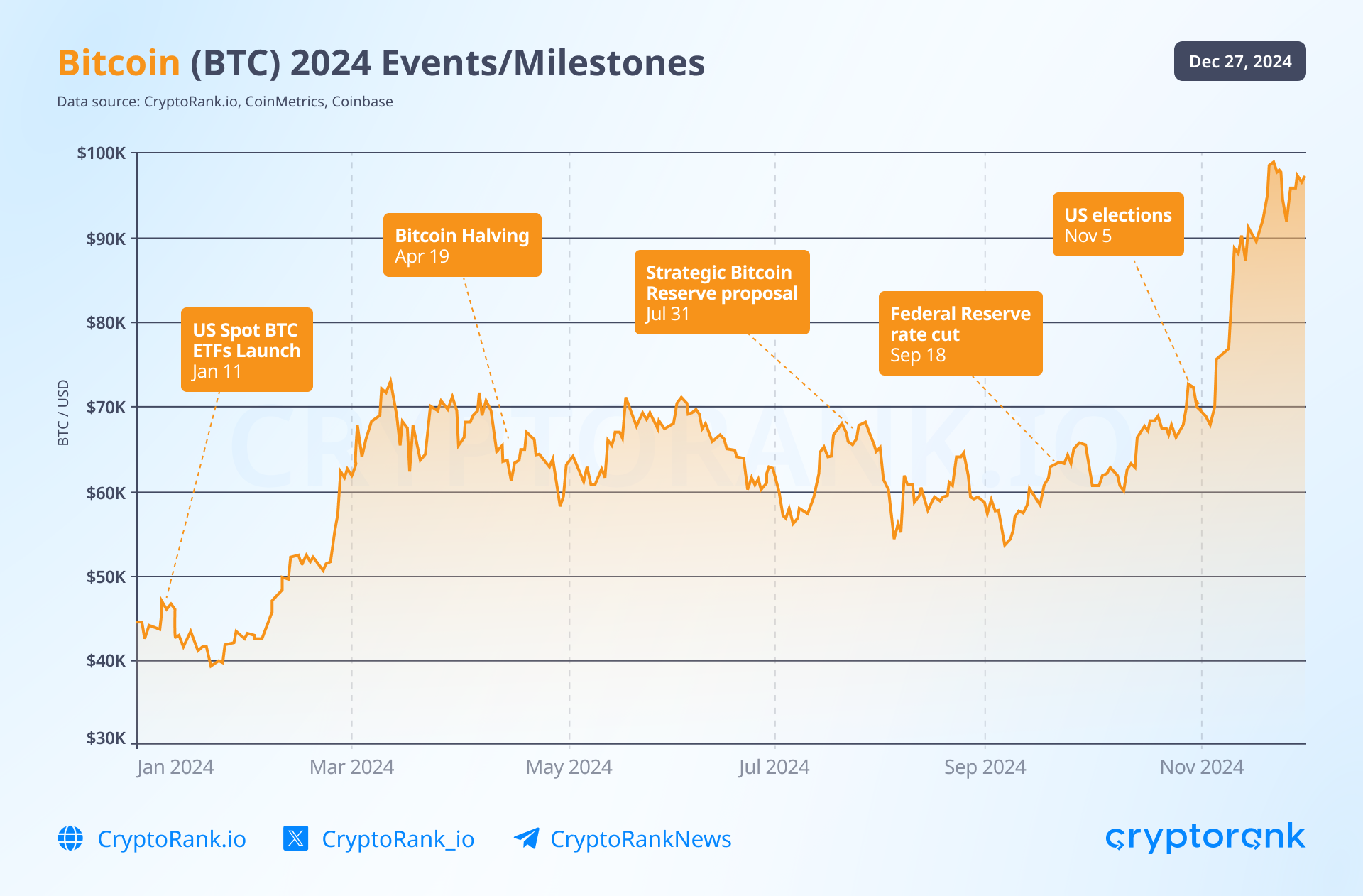
Interestingly, many public figures foresee further growth in Bitcoin’s price. However, it’s important to note that these forecasts often come from individuals or groups with bullish inclinations.
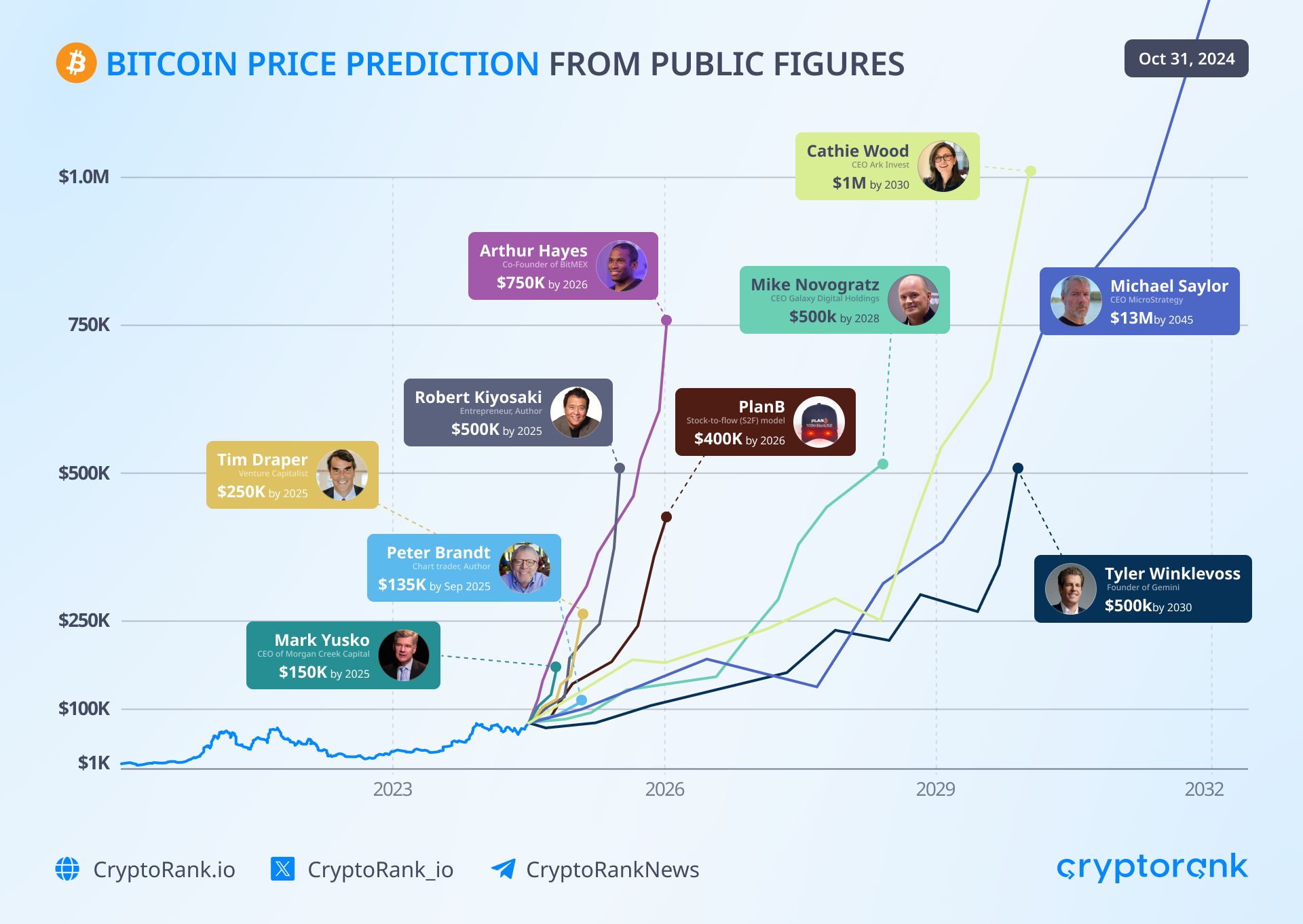
A more measured and potentially accurate perspective comes from investment funds. Their forecasts tend to be closer to reality—while still bullish, they are more restrained compared to the optimism seen in public narratives.
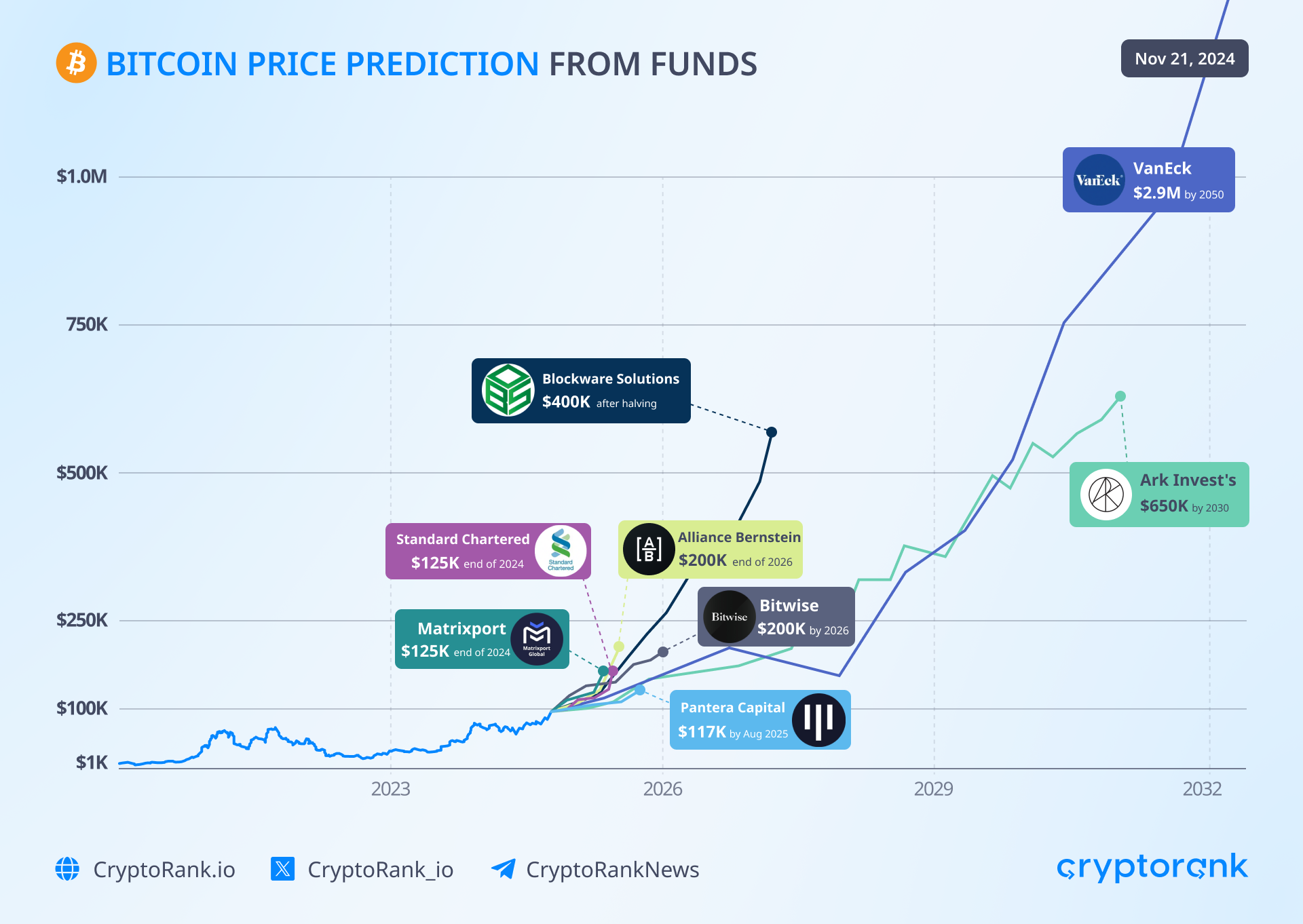
Analysis of the Top 10 Cryptocurrencies by Market Capitalization
As of January 1 2025, changes within the top 10 cryptocurrencies by market capitalization over the past year were minimal. However, the price dynamics of these coins offer intriguing insights.
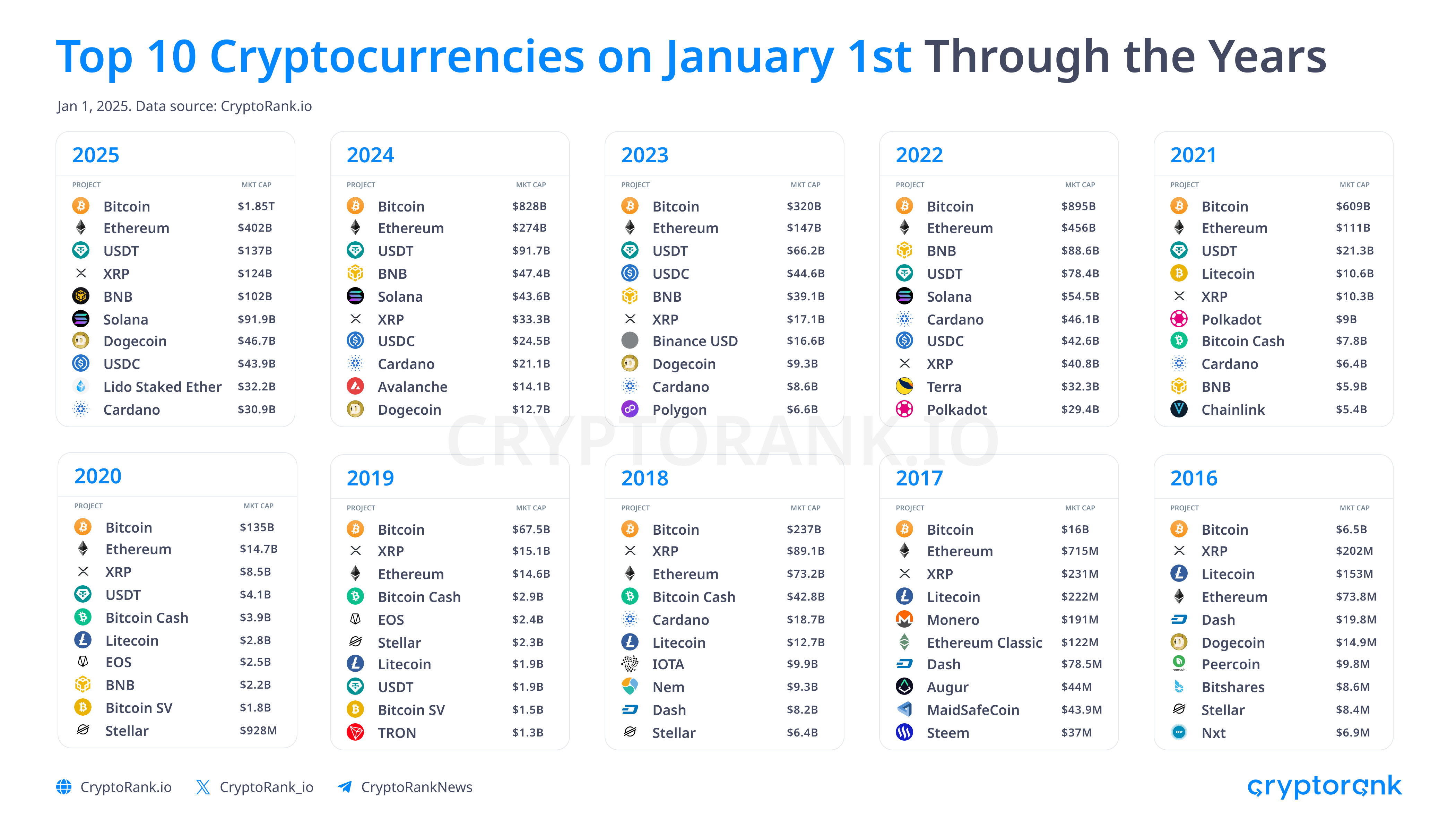
Ethereum (ETH)
Ethereum’s price performance in 2024 lagged behind Bitcoin, with Ethereum rising by 47% compared to Bitcoin’s 119%. The main catalyst for Ethereum’s growth was the approval of the first spot ETF for the asset, which boosted investor confidence. However, when trading for the ETF began, Ethereum’s price dropped—a classic example of 'buy the rumor, sell the news,' where the hype of the approval drove prices up, but profit-taking pulled them back down. Interestingly, Ethereum’s price also saw a sharp rally following Donald Trump’s election victory, reflecting heightened market optimism and expectations of more crypto-friendly policies.
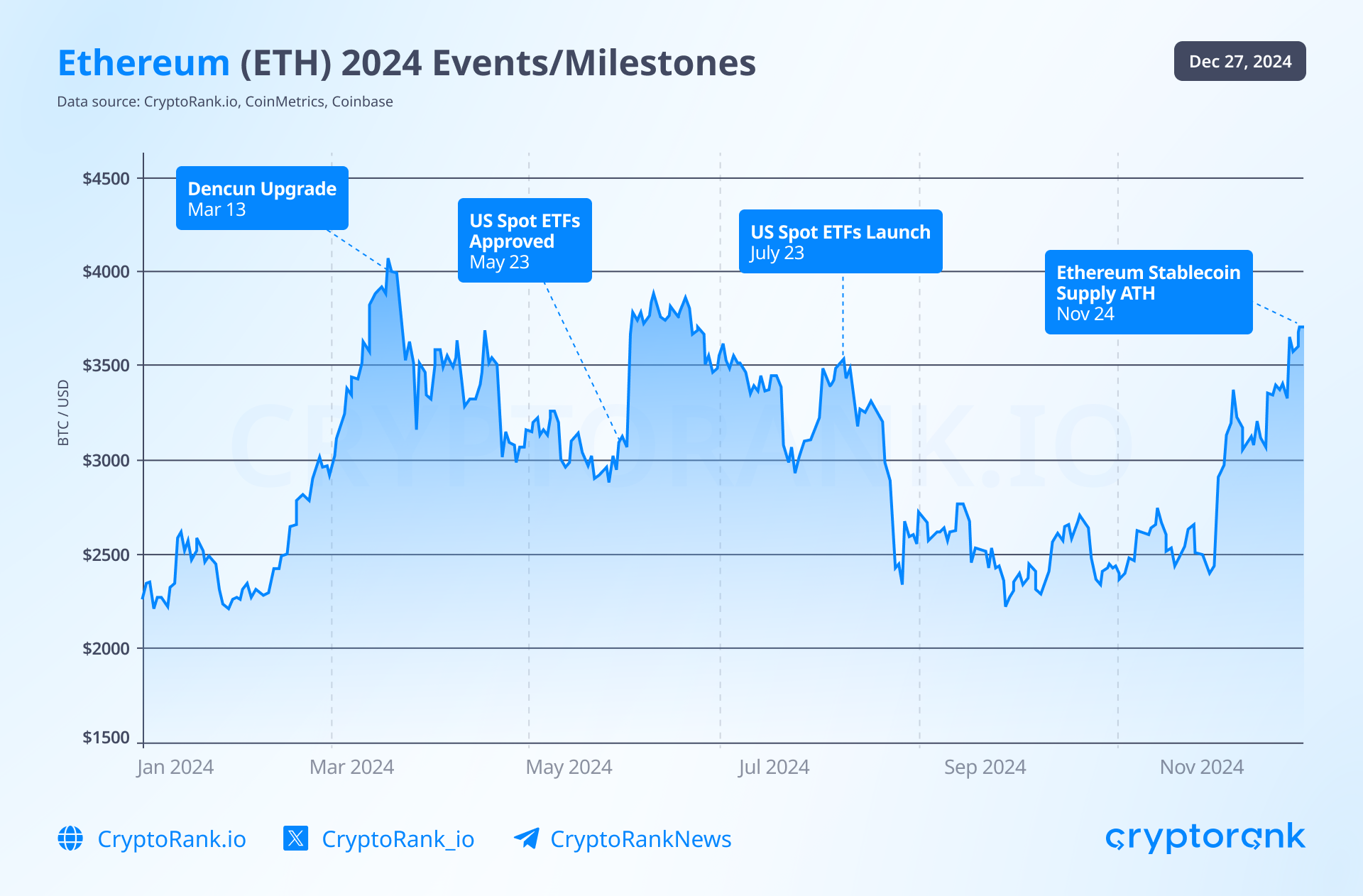
BNB (BNB)
BNB exhibited steady and consistent growth throughout 2024, with the majority of gains occurring early in the year. As an altcoin, BNB's relatively low volatility makes it attractive to investors seeking exposure to altcoins while avoiding excessive price swings.
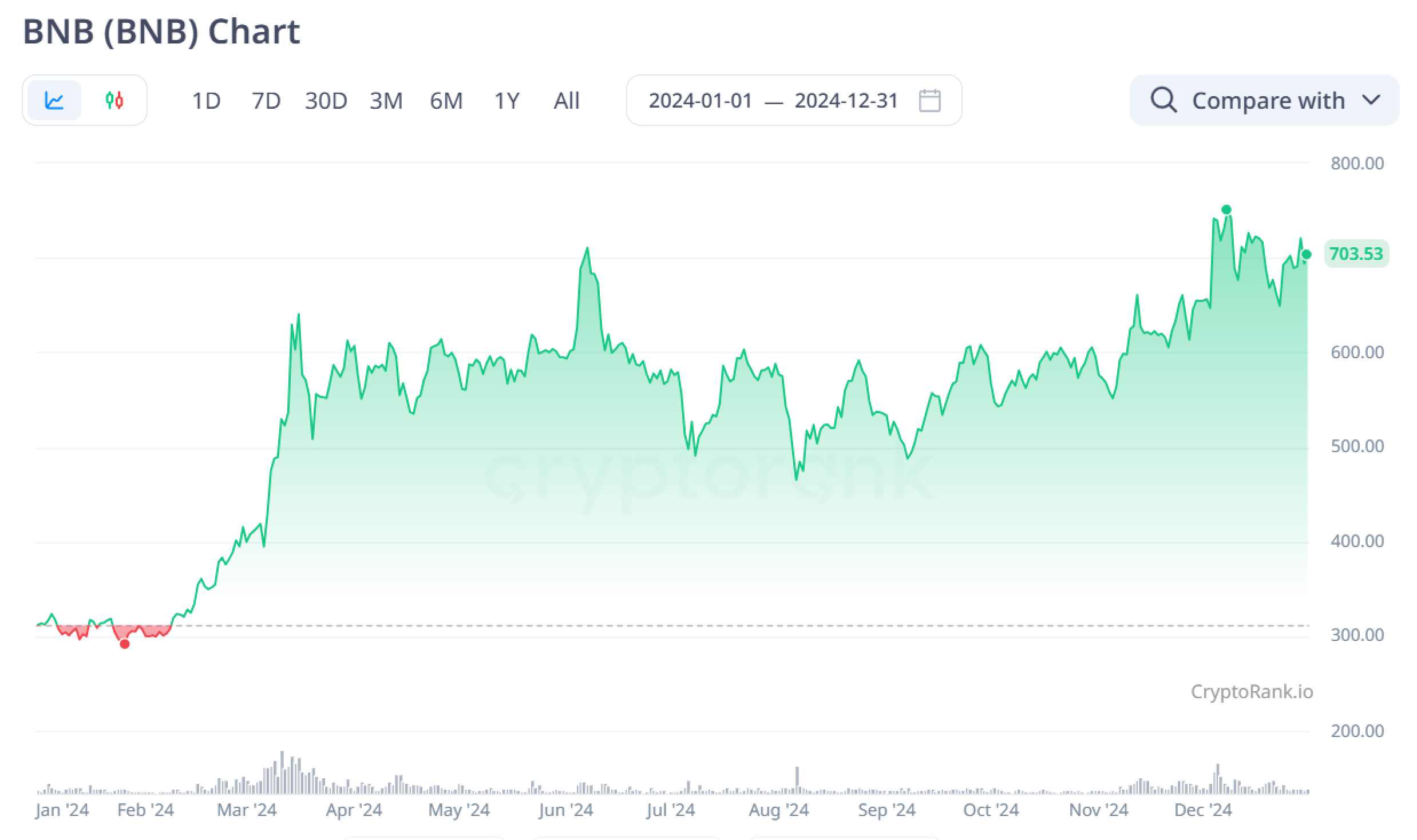
Solana (SOL)
Similar to most cryptocurrencies, Solana’s primary growth phases occurred at the start and end of the year, with prolonged sideways trading in between. Clearly defined support and resistance levels were observed within the sideways range. These levels may serve as key support zones in the future, while a breakdown could signal a transition to a bearish market phase.

XRP (XRP)
Unlike ETH, BNB, and SOL, XRP’s chart appears more artificial, characterized by low volumes and volatility throughout the year, followed by a sudden price spike in late 2024. Based on past price patterns from 2017 and 2021, XRP could experience another significant decline after its sharp rise. Despite its high market capitalization, XRP’s practical use and adoption remain notably low.
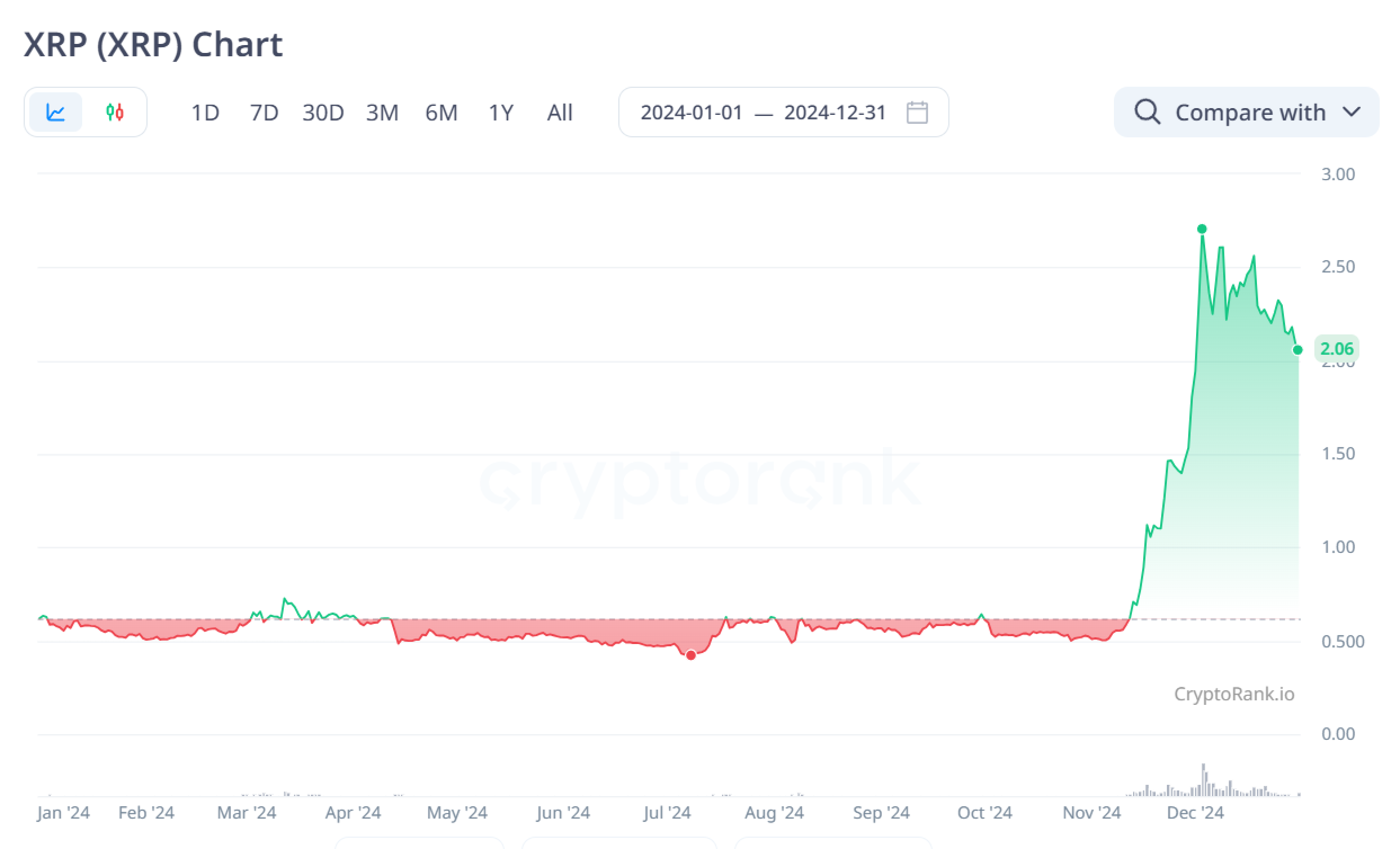
Cardano (ADA)
Cardano displayed a similar speculative price pattern, with a gradual decline for most of 2024 and a sudden spike at the end of the year. ADA, like XRP, has a history of pump-and-dump cycles, with peaks in 2017 and 2021 followed by steep crashes.
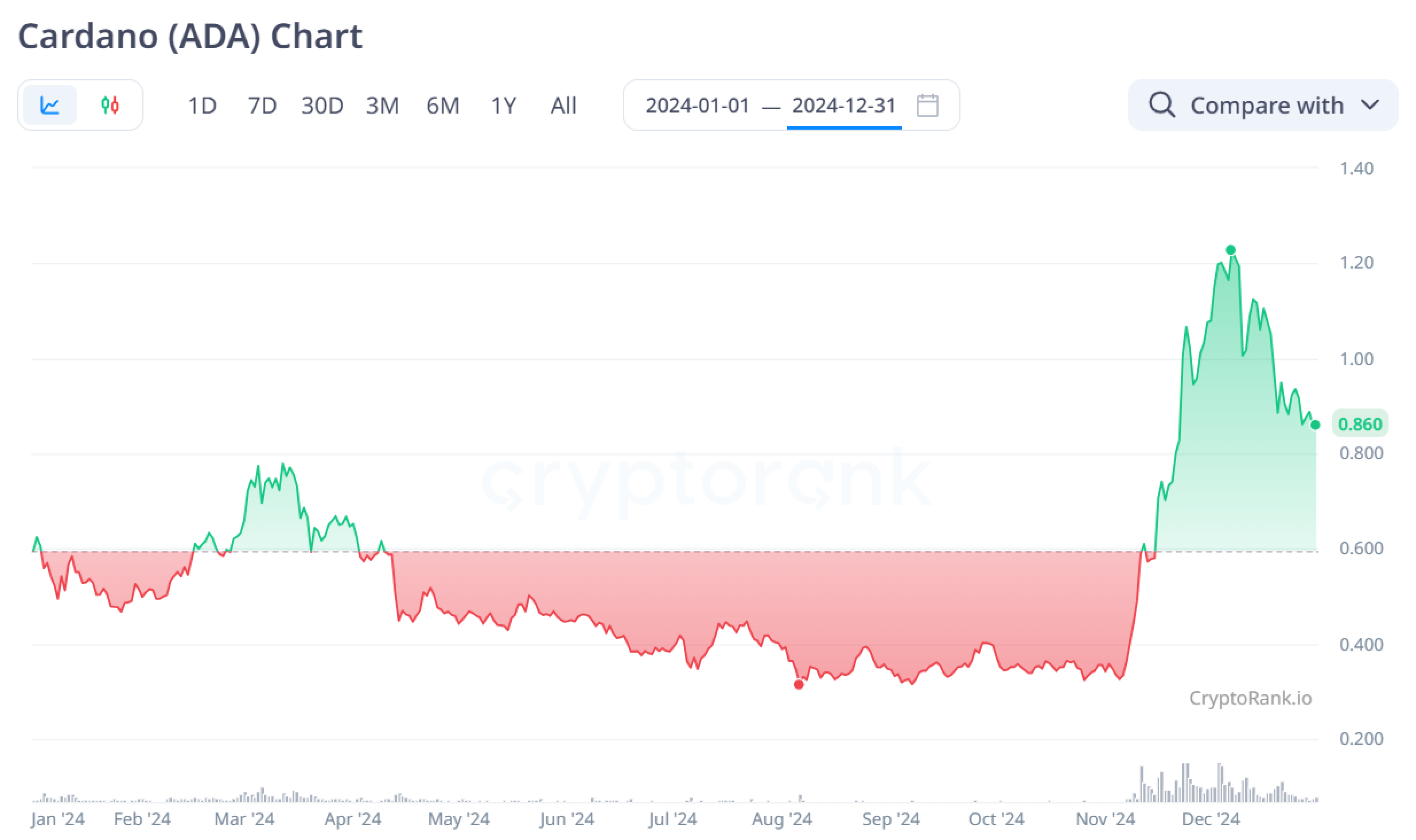
Dogecoin (DOGE)
Dogecoin remains the leading meme coin by market capitalization. Its price dynamics mirrored those of BNB and SOL, with growth at the start and end of the year. However, unlike BNB and SOL, Dogecoin experienced a downward-sloping sideways trend for most of the year.

Top 10 Charts Overview: Key Conclusions & Strength Rankings
- Strongest: BTC, BNB, SOL—exhibiting sustained sideways trading with solid support, these coins show natural price dynamics, being less susceptible to manipulation by market makers.
- Moderate: ETH—showing two support levels, with $2,000 being stronger, but still prone to some price fluctuations and manipulation.
- Weaker: XRP, ADA, DOGE—highly speculative, following pump-and-dump schemes, and likely to experience price declines in 2025 due to manipulation and market instability.
Sector Analysis
Let’s broaden our perspective and explore the cryptocurrency market beyond the top 10 by dividing coins into sectors.
The strongest sector in 2024 was the memecoin sector, while the weakest performers were NFT, SocialFi, Currency, and GameFi.
The success of meme coins has been analyzed extensively in our previous articles. Their strength lies in several factors: the absence of VC capital suppressing prices, 100% circulating supply, strong ties to narratives or events, and their ease of pumping, which often leads to substantial returns.
In contrast, the weak performance of NFT, SocialFi, Currency, and GameFi sectors can be attributed to one common issue: a lack of innovation. While other sectors did not introduce groundbreaking innovations comparable to the DeFi boom of 2020–2021, they have shown gradual improvement with new solutions. However, the aforementioned sectors failed to demonstrate any notable progress.

Blockchain Analysis
Blockchains can be assessed using various metrics, but Total Value Locked (TVL) remains the most significant. In 2024, Bitcoin solidified its status as the year’s most trending blockchain, leading in TVL growth and outpacing its competitors by a wide margin. Newer blockchains like Scroll and Mantle also showed remarkable growth, driven primarily by their low starting base and lucrative airdrop campaigns. Among these, Solana stood out as the only established blockchain without the low-base advantage, achieving significant success thanks to a booming meme-coin ecosystem.
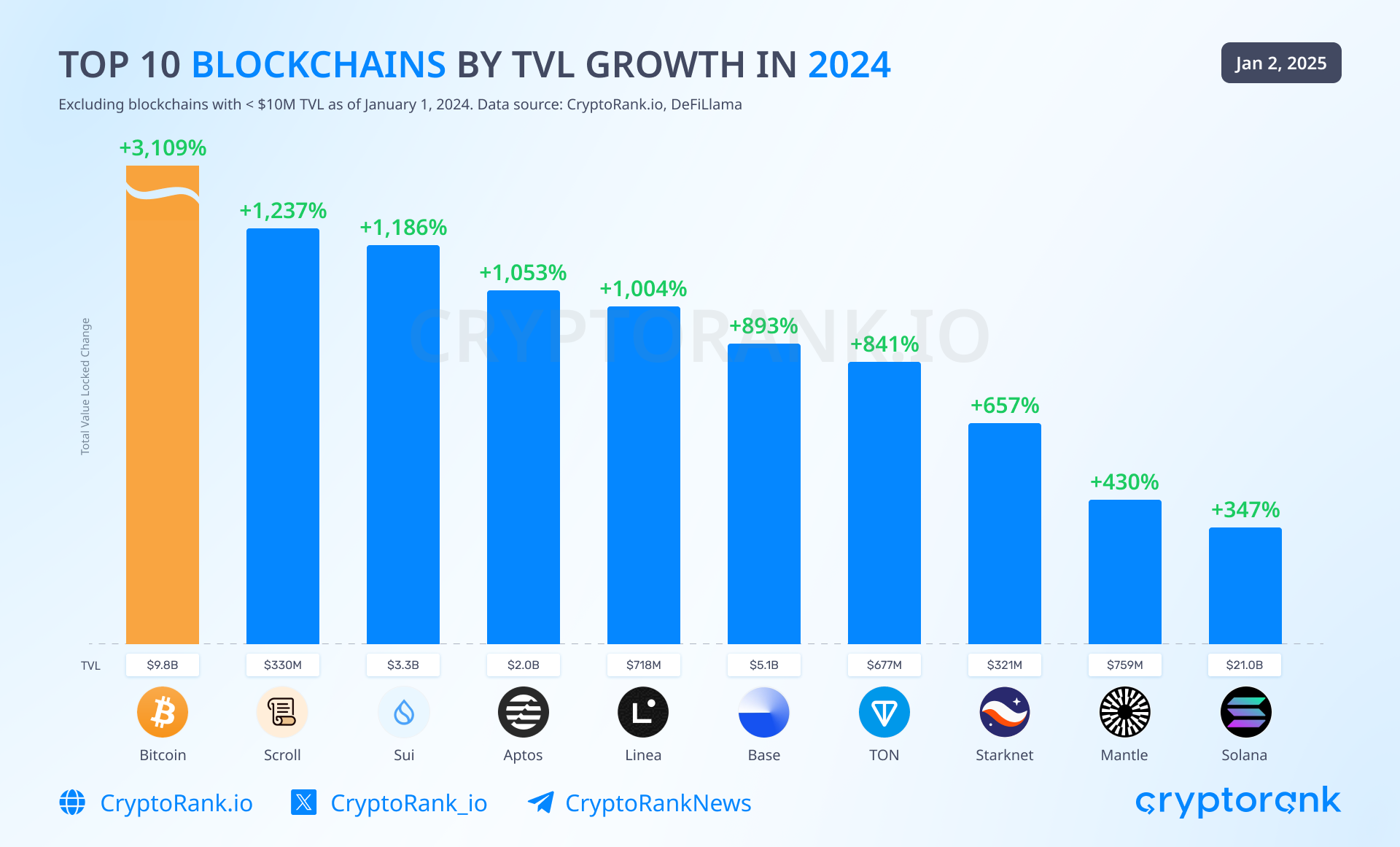
The second most important metric is trading volume on decentralized exchanges (DEXs). Solana’s surge in popularity brought its trading volume nearly on par with Ethereum’s. Despite lacking compelling narratives or standout projects in 2024, BNB Chain and Arbitrum leveraged their market positions to secure third and fourth places in DEX trading volume.
Base and Blast, both Layer 2 solutions built on top of Ethereum, ranked fifth and sixth, though their strategies diverged. Base emerged as one of the year’s trendiest ecosystems, introducing unique innovations like Farcaster while capitalizing on trends such as the meme-coin boom. It attracted significant user activity, driven by speculation about future airdrop rewards, even without officially announcing one. In contrast, Blast relied on a well-timed and effective airdrop campaign. However, its metrics began to decline after the campaign ended.
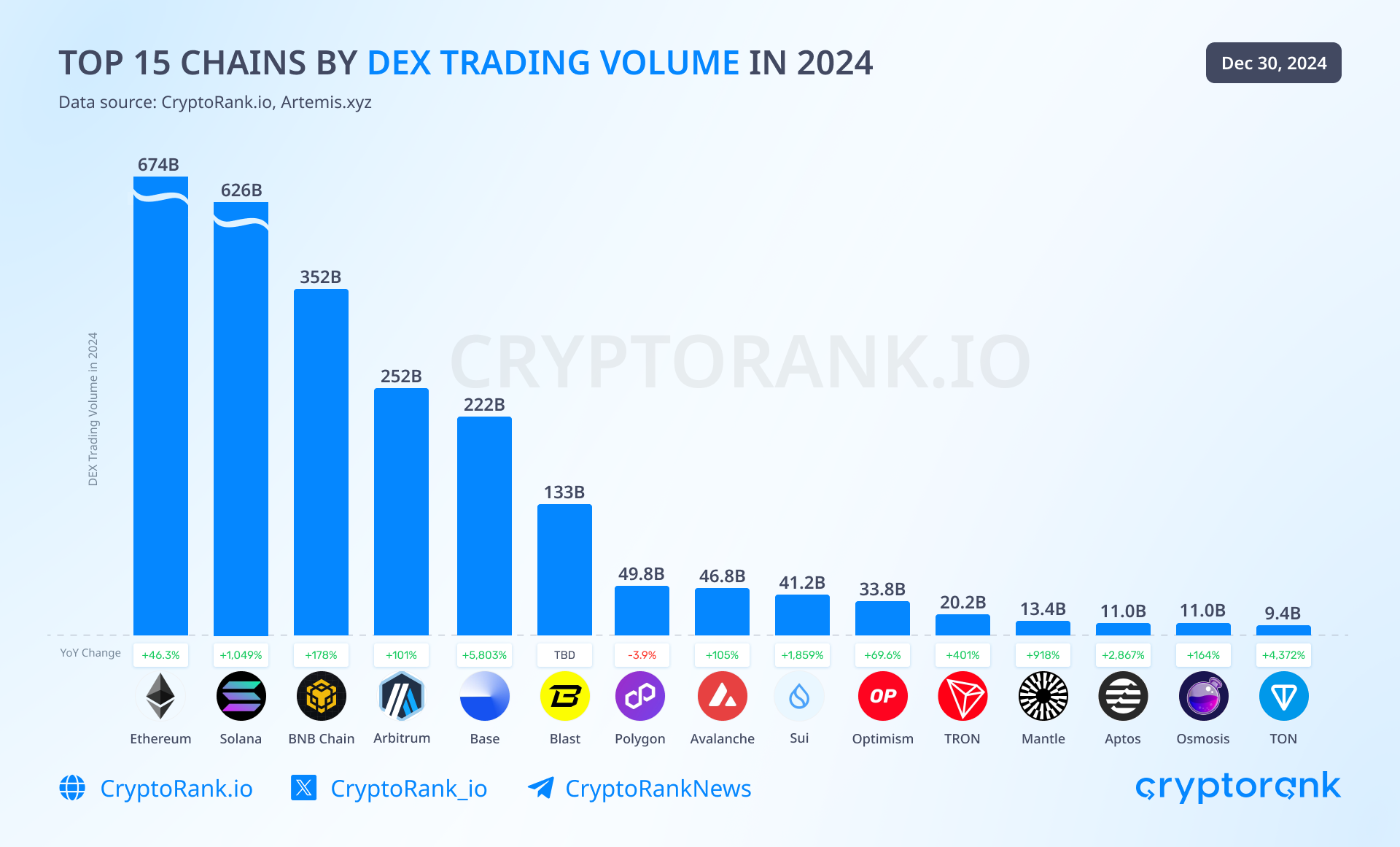
Stablecoin transfer volume is another crucial metric where Solana surpassed Ethereum to claim the top spot. TRON maintained a strong position, cementing itself as a go-to platform for stablecoin transactions. Base also excelled in this category, outperforming BNB Chain and Arbitrum, which ranked fifth and sixth, respectively.
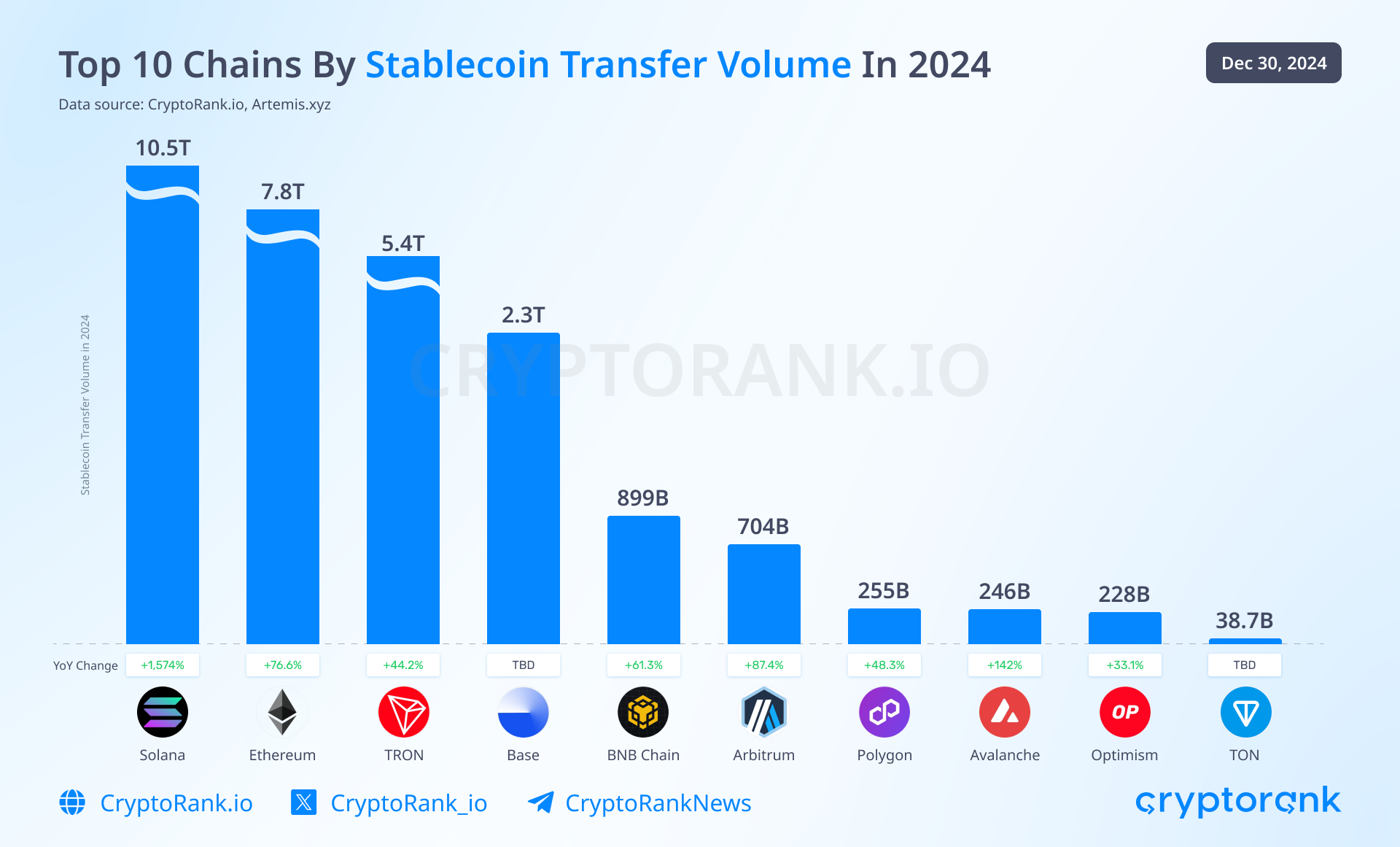
In terms of revenue, Ethereum remains the undisputed leader, far outpacing all other blockchains. TRON secured second place, primarily due to increased stablecoin transfers, though its brief meme-coin surge contributed marginally. Solana recorded the highest revenue growth, driven by a resurgence in DeFi activity and the meme-coin boom.
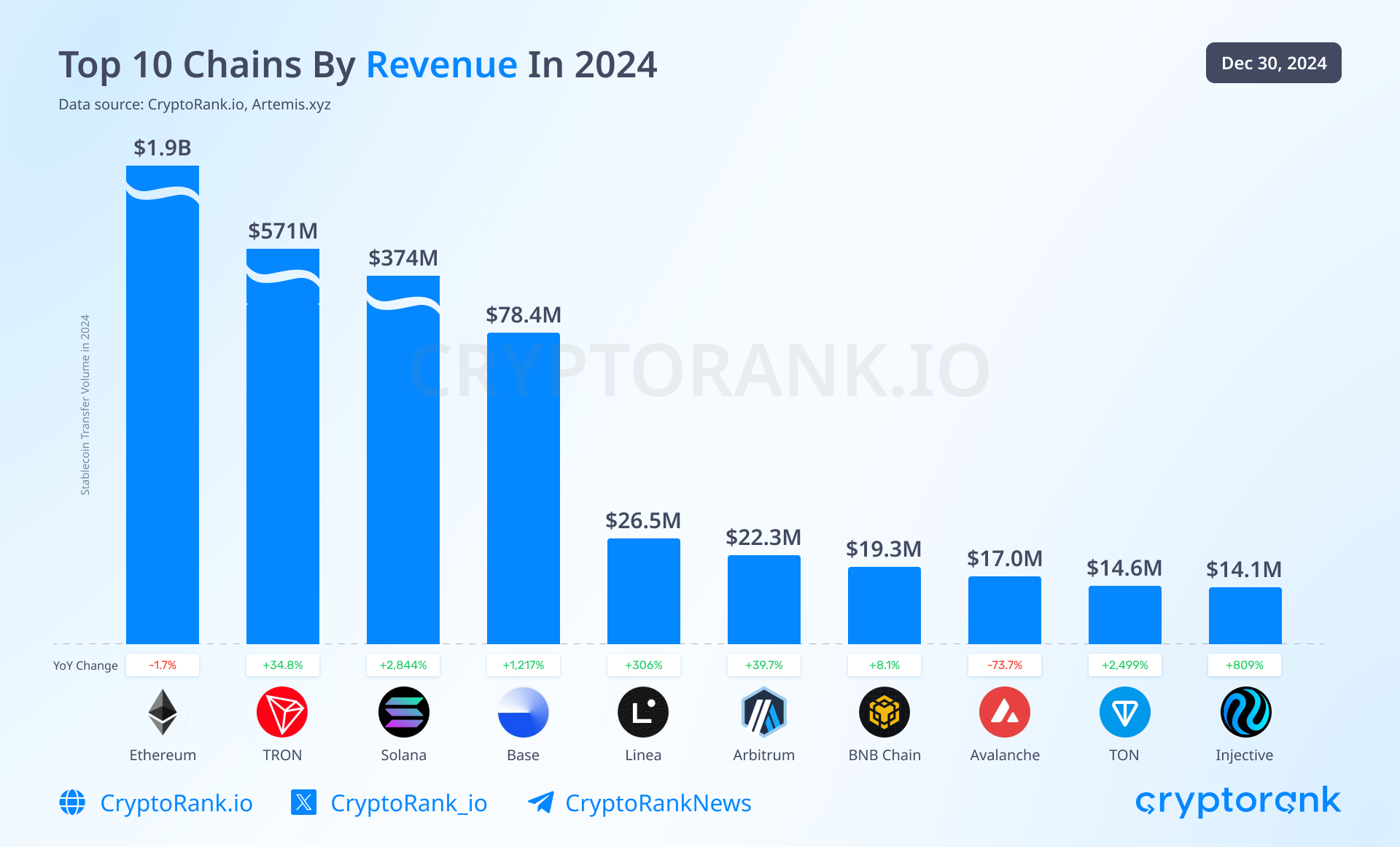
NEAR Protocol delivered a surprising result by leading in daily active addresses (DAA), narrowly surpassing Solana. However, NEAR’s relatively low community engagement raises the possibility that a notable portion of these addresses could be driven by automated or non-human activity. Solana followed closely, with TRON securing third place due to its widespread use for stablecoin transactions.

Conclusions
Ethereum vs. Solana
The competition between Ethereum and Solana is intensifying. 2024 was a standout year for Solana and comparatively weak for Ethereum. If this trend continues, Solana could potentially surpass Ethereum as the leading blockchain. However, it’s too early to draw definitive conclusions — 2025 will be crucial in determining their trajectories.
Bitcoin's Rise in TVL
Bitcoin climbed to 3rd place in TVL, trailing only Ethereum and Solana. With over 70 second-layer scaling solutions under development, Bitcoin’s DeFi ecosystem is likely to be a major narrative in 2025.
Base’s Rapid Growth
Base emerged as the leading L2 blockchain, excelling across multiple metrics. Its development mirrors the early days of BNB Chain — a blockchain backed by an exchange, fostering rapid ecosystem growth and experimentation. However, the fierce competition among L2 blockchains leaves its 2025 position uncertain.
TON’s Expansion
TON broke into the top 10–15 across all key metrics, albeit at the lower end. With Telegram’s support and the integration of mini-apps built on TON, the network is well-positioned for further growth in 2025.
DeFi Sector
The DeFi sector is steadily evolving, with incremental improvements in existing products and user experiences. Although DeFi underperformed in profitability and hype compared to meme coins, it's important to remember that much of the crypto user experience revolves around DeFi applications. The growth of the crypto market as a whole positively impacts the DeFi sector.
While DeFi dApps experience significant turbulence, certain niches have established clear leaders. For instance, Aave continues to dominate as the top lending protocol and the leading dApp by TVL. Uniswap remains the leader in trading volumes among DEXs and has surpassed Curve to take the top spot in TVL within the DEX category. Meanwhile, fierce competition exists in emerging niches, such as liquid restaking protocols, where ether.fi has seemingly secured its position as the leader.
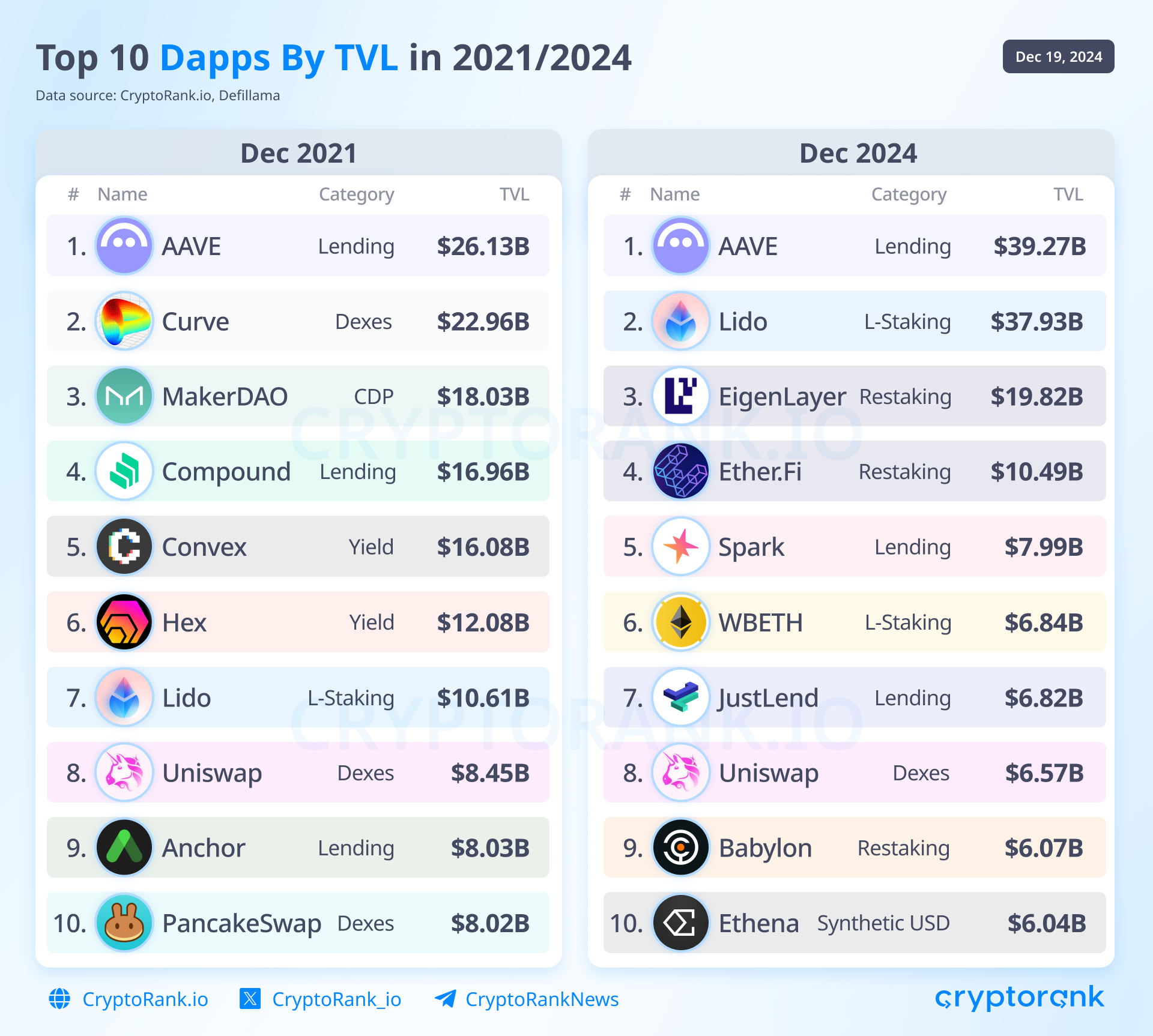
At the end of the year, Hyperliquid surprised the market with an airdrop and peaked at a fully diluted valuation of $30 billion. Hyperliquid operates as a dApp-specific blockchain centered around a derivatives exchange. Its success, along with the rise of infrastructure projects for creating dApp-specific blockchains, signals a potential trend for 2025. These blockchains are expected to compete less with general-purpose blockchains and more with specific dApps in terms of business logic and key metrics.
The DeFi sector is vast, encompassing numerous protocols with diverse business models and metrics. While a detailed comparison of all subcategories would require a separate article, it’s clear that the sector is expanding with the emergence of new protocols and the refinement of existing ones.
Prediction Markets
One of the trending niches in 2024 has been prediction markets. Although this space has existed in Web3 for over four years, it only gained significant popularity in 2024, largely due to betting on the U.S. elections.
The advantages of prediction markets over traditional betting platforms are clear: the most important factor is that users can be confident in the security of their funds, as they are stored on the blockchain. Unfortunately, many betting platforms lack reliability in this regard. Additionally, prediction markets offer anonymity and accessibility for all users, with no need to reveal one's identity and no registration restrictions.
Prediction markets have significant potential, as they can be used not only for gambling but also as a tool for hedging.
Polymarket stands out as the clear leader in the prediction market space, with a peak TVL of $545 million and a trading volume that exceeded $2 billion at its height.
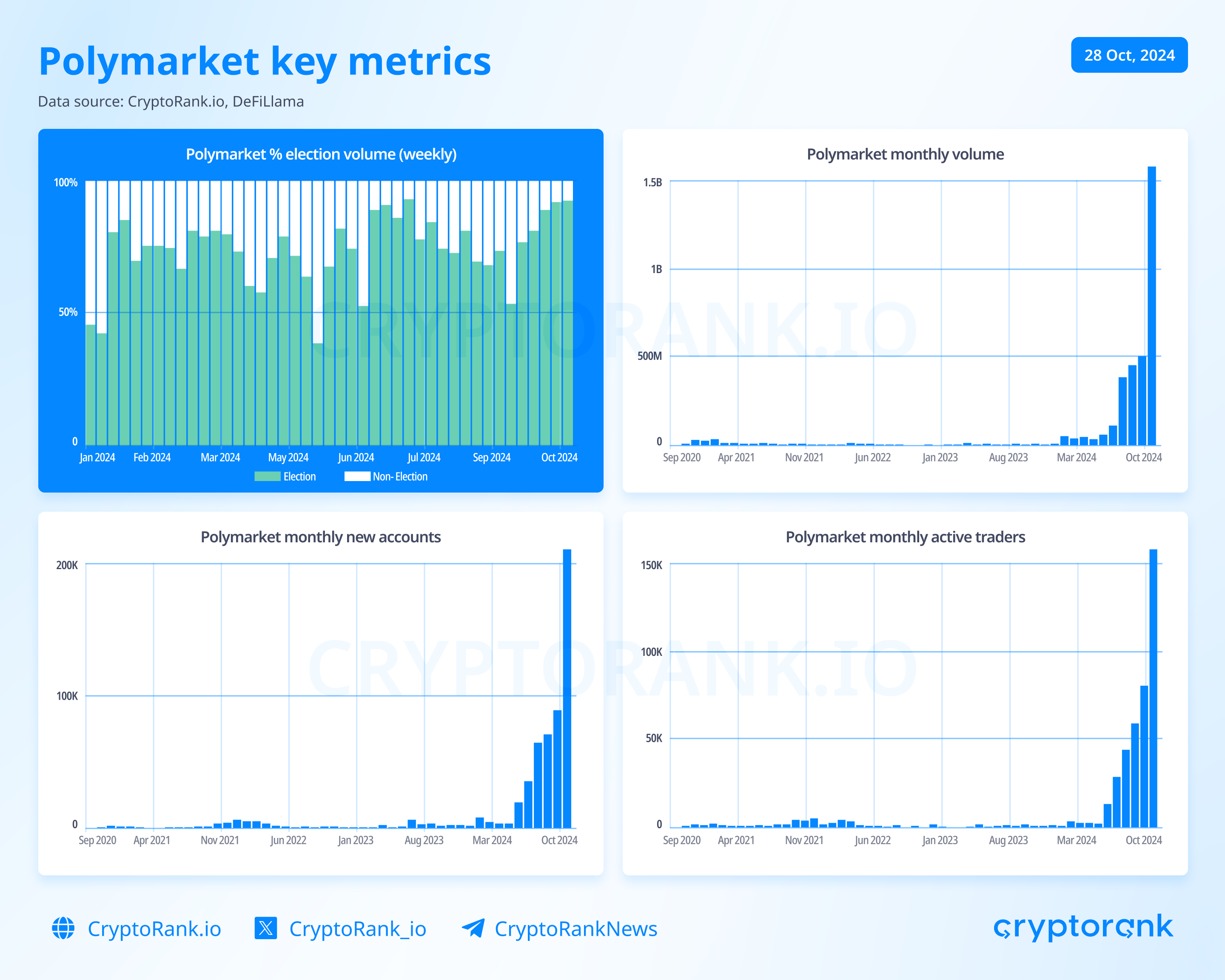
Polymarket gained popularity even outside the crypto community, being mentioned by Donald Trump in one of his speeches and referenced by mainstream media outlets when covering the U.S. presidential elections.
However, after the elections, the popularity of all prediction markets, including Polymarket, sharply declined, leading to a drop in key metrics: TVL, trading volume, new user registrations, and bet counts.
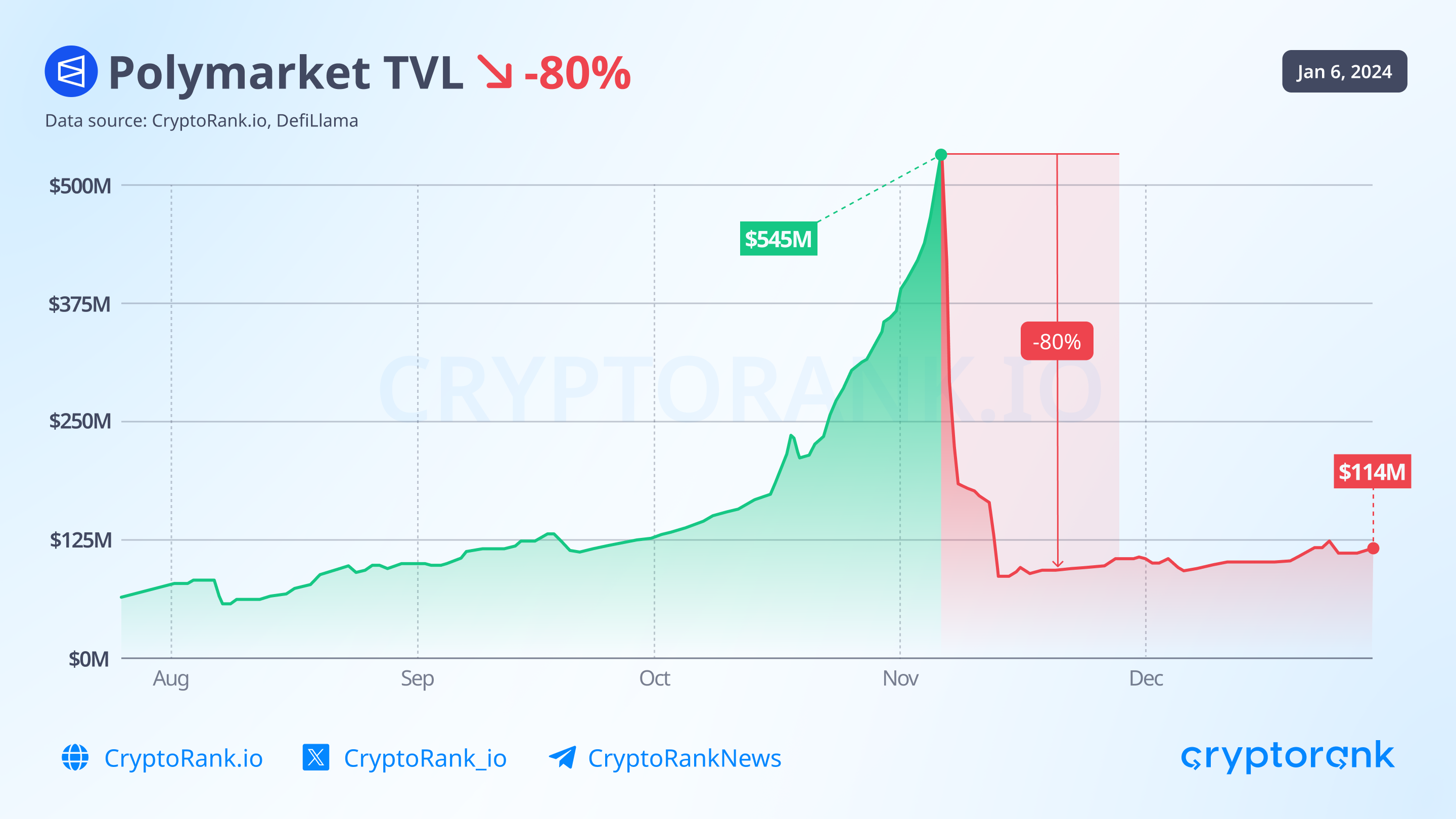
Despite this, prediction markets are in a better position now than at the beginning of 2024. Many users have tried Polymarket or other alternative platforms, and some have remained. Those who left can always return if a major event, such as the U.S. elections, sparks interest again. In one of our articles, we explored the future of prediction markets after the 2024 elections.
Meme Coins
Meme coins delivered the highest returns among all crypto categories in 2024. Their success likely stems from being one of the few areas in crypto capable of providing returns exceeding 10x.
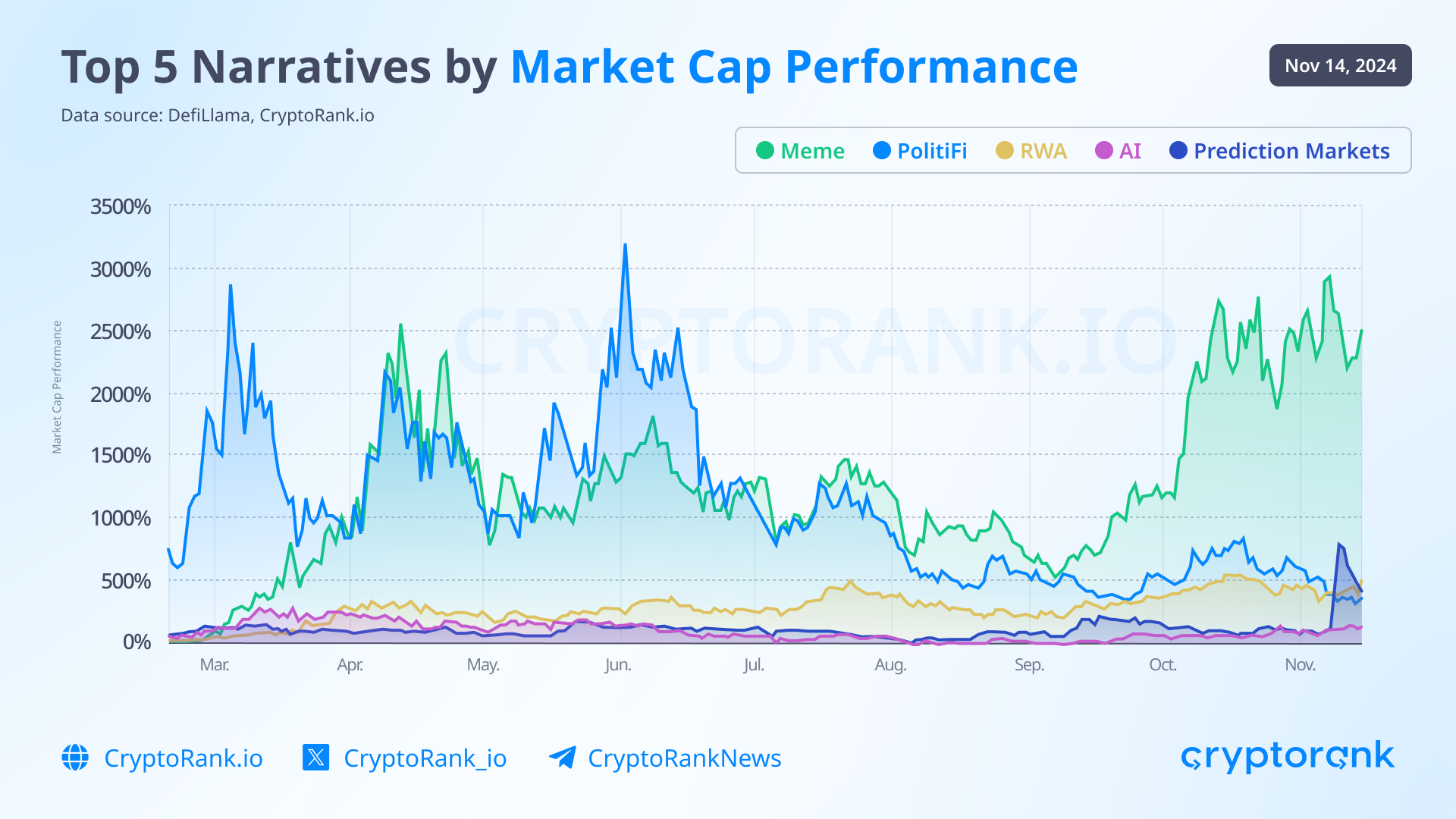
A key driver of this trend was meme launchpads, particularly pump.fun on Solana, which became the top-performing dApp by revenue in 2024.
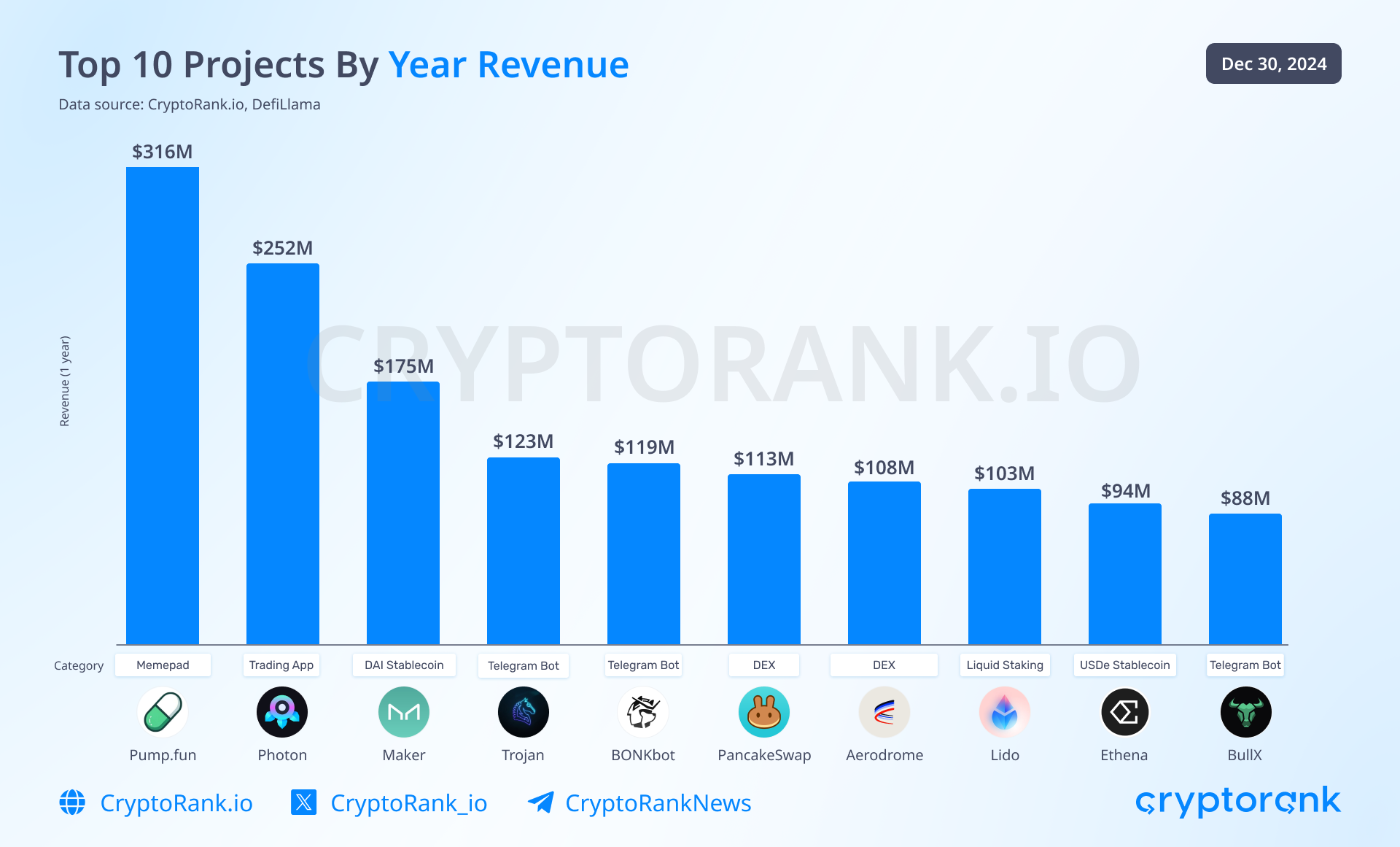
Other blockchains attempted to replicate pump.fun’s success. By late summer, Sunpump emerged as a competitor but failed to sustain its momentum, and by September, pump.fun reclaimed its dominance.
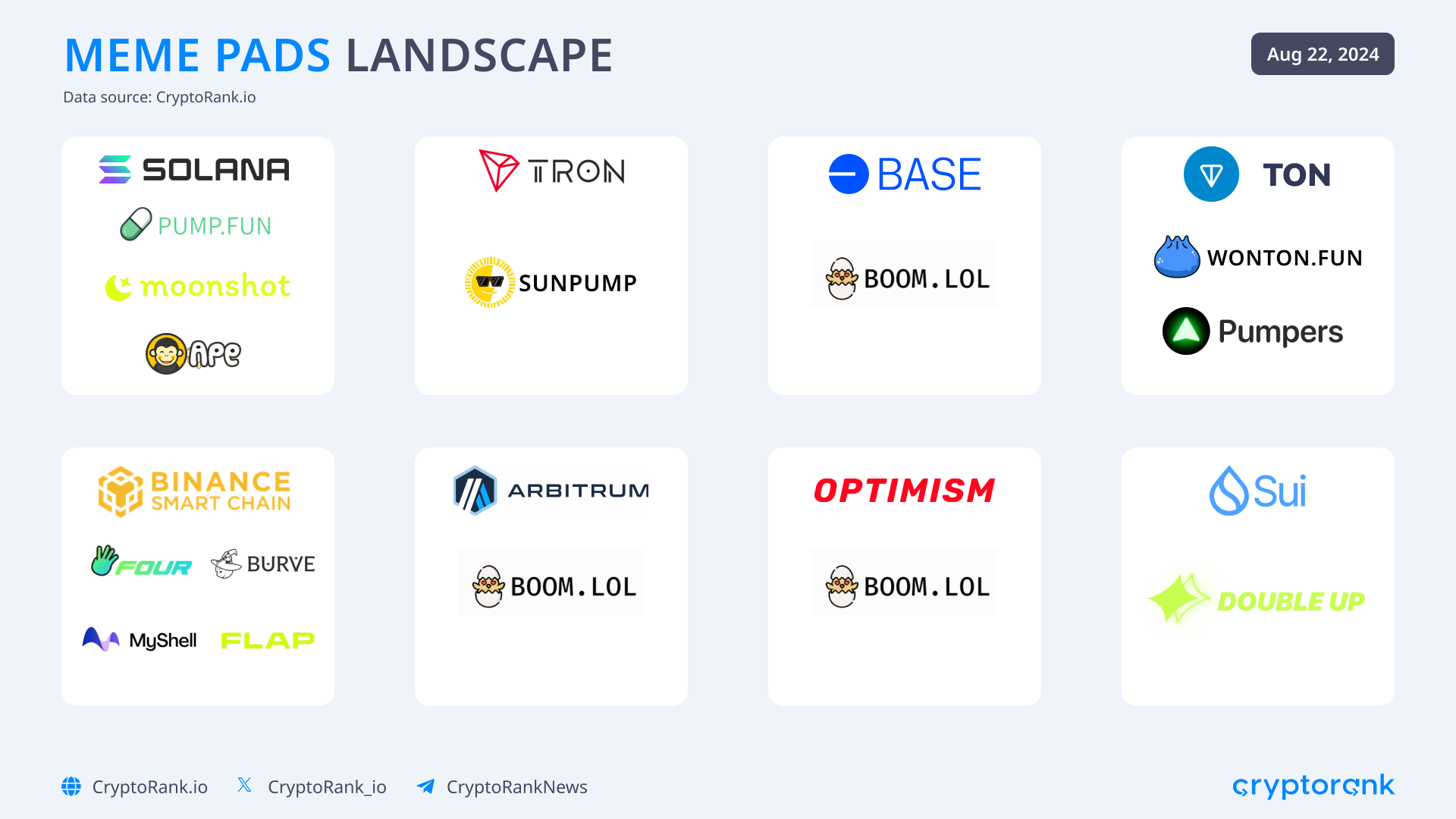
Meme coins significantly boosted Solana’s trading volumes on DEXs and helped it outperform other blockchains in numerous metrics.
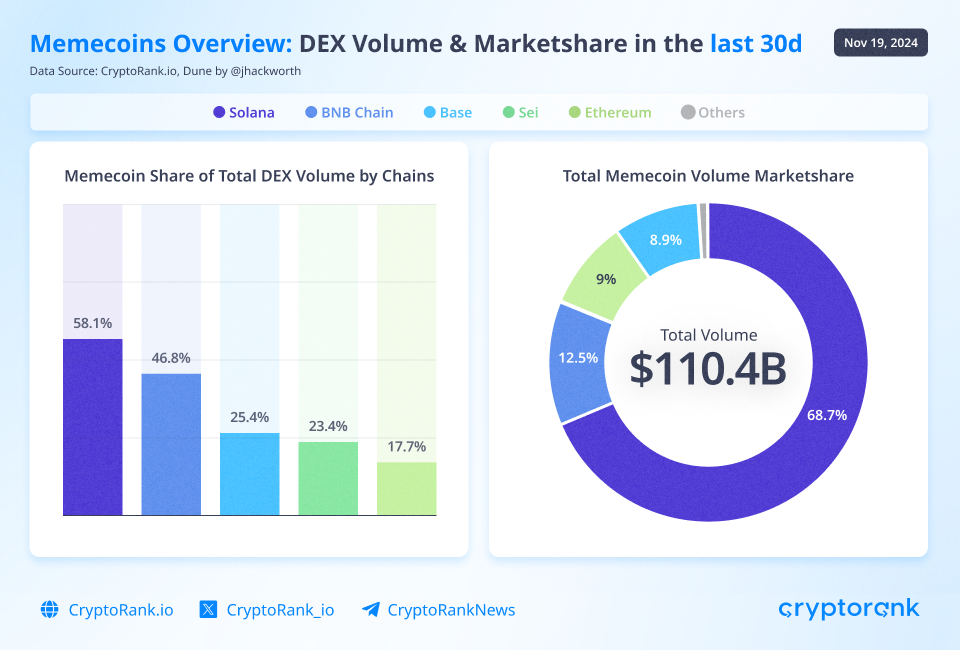
The meme coin boom was sudden, and given the lack of underlying utility in this niche, it is challenging to predict whether the euphoria will persist into 2025. However, if the trend continues, it could further fuel the success of blockchains like Solana that thrive in this space.
Blockchain Infrastructure
Infrastructure projects often attract less attention than meme trading and provide lower financial returns. However, they address fundamental challenges faced by the crypto industry.
Among the top 10 infrastructure projects launched in 2024, several key narratives emerged: restaking, blockchain interoperability, AI integration, bridging off-chain and on-chain data, and infrastructure for building dApp-specific blockchains.
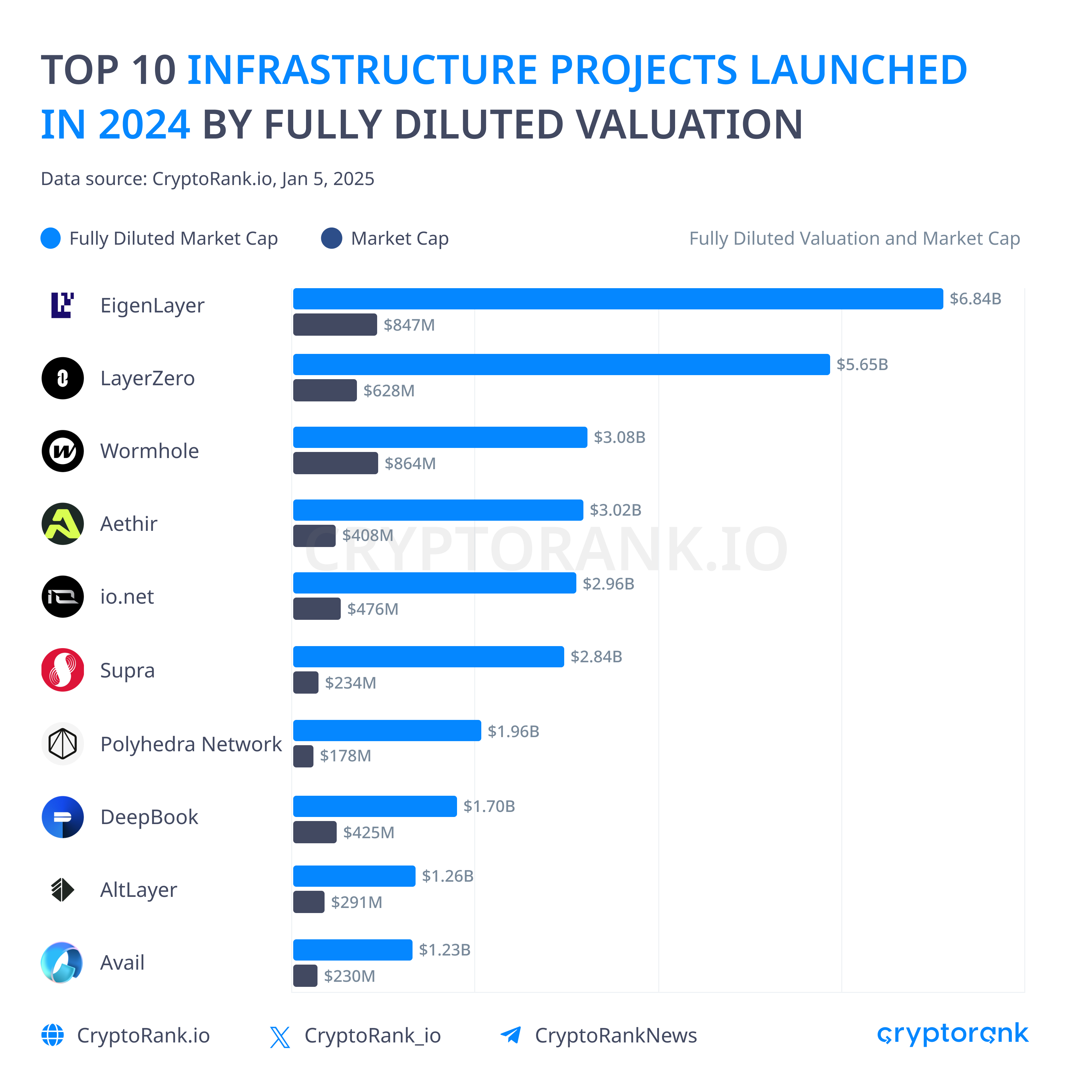
GameFi
In 2024, Tap-to-Earn games and Telegram mini-games dominated the GameFi sector. Notable successes included Hamster Combat, which reported 50 million daily active users at its peak and a total of 300 million users, and Notcoin, which attracted 30 million users. At their height, Tap-to-Earn games outpaced all other game categories combined in terms of user numbers.
Despite this impressive growth, Tap-to-Earn games faced two major challenges. First, their popularity waned after initial airdrops failed to meet user expectations due to the sheer number of participants. Second, these games, like most Telegram mini-games, relied less on on-chain transactions.
Overall, the number of new games released annually has plateaued at around 800 over the past four years.
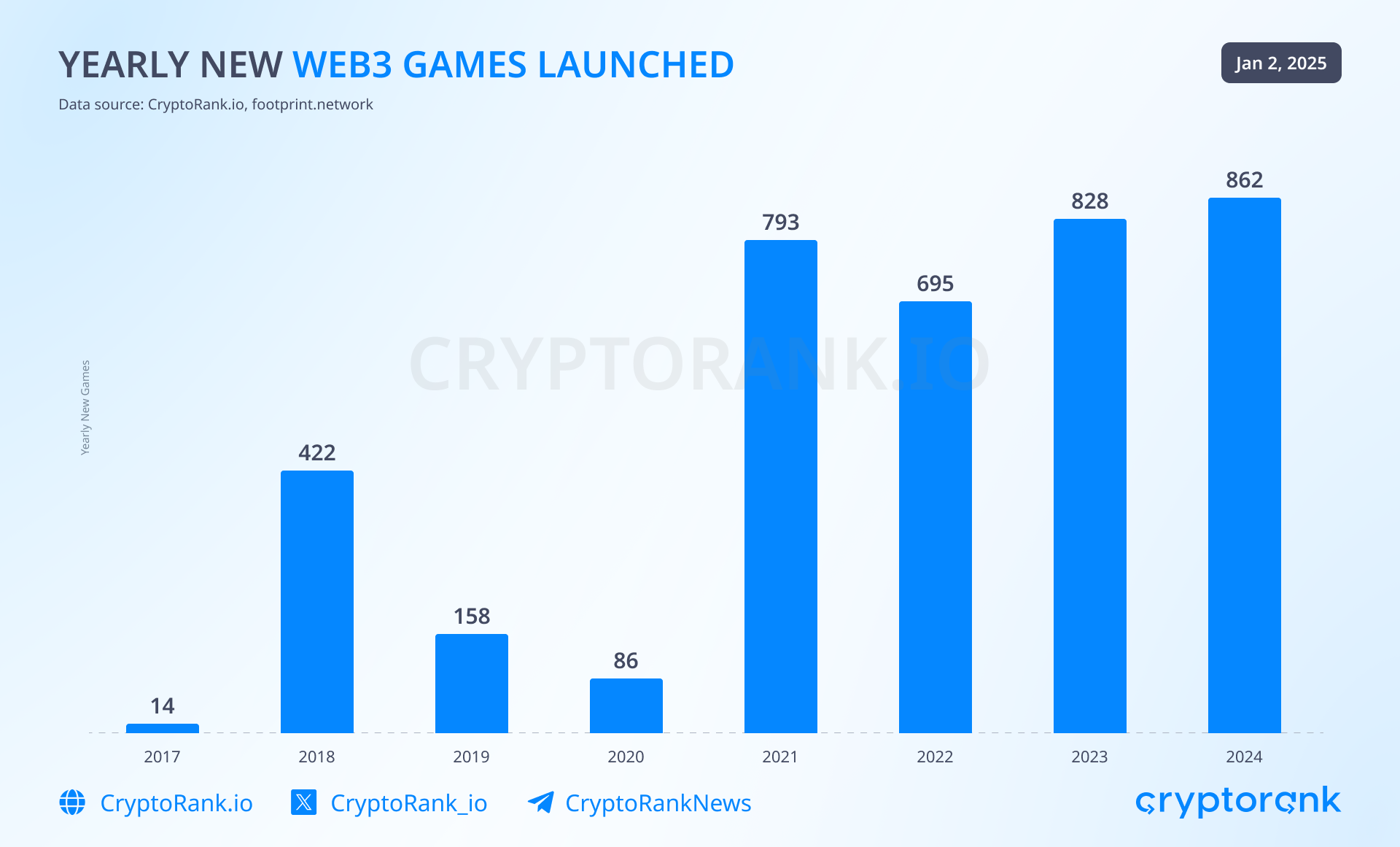
However, 2024 was a strong year for user growth after a stagnant 2023.
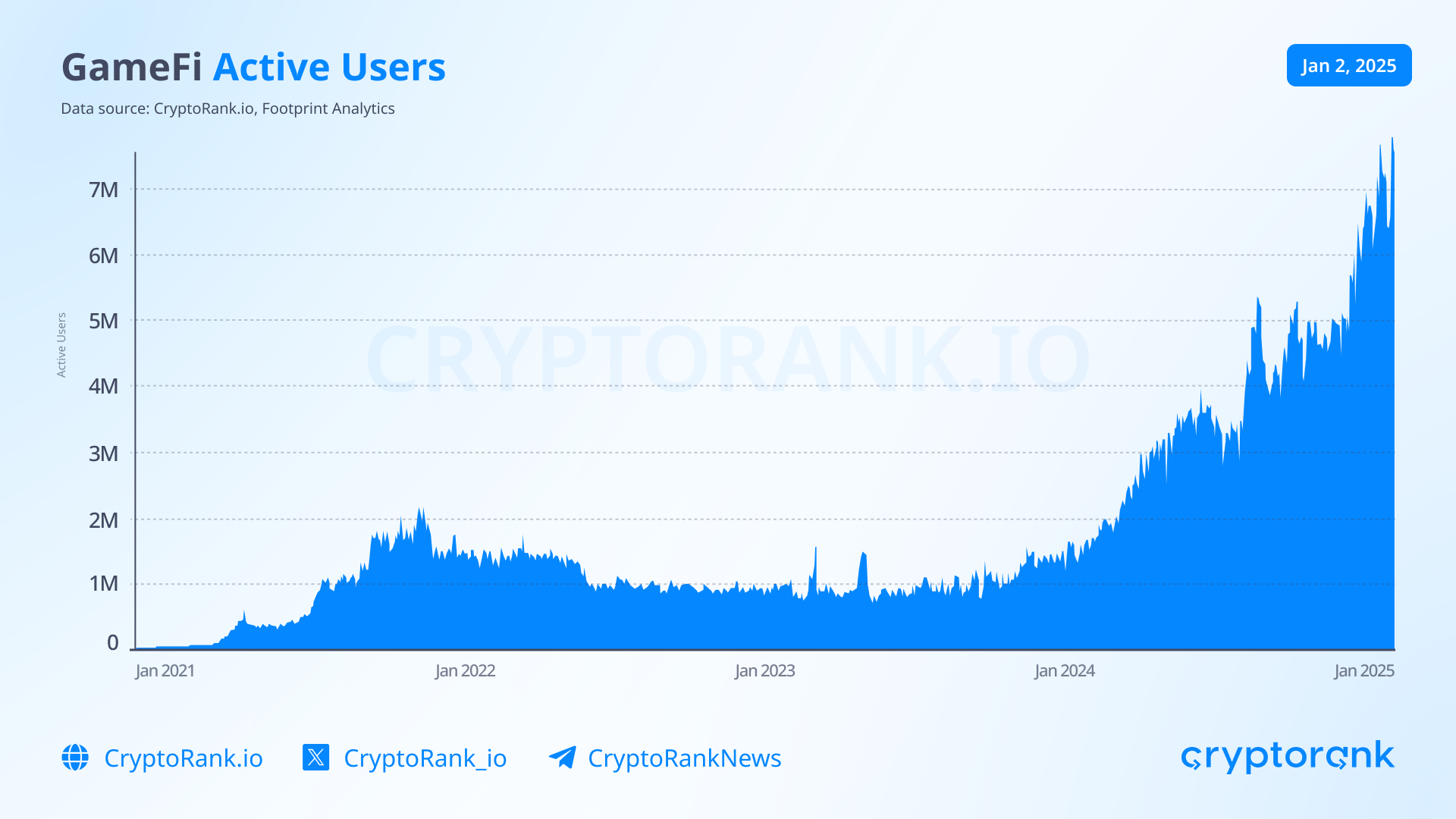
The current formula for success in GameFi leans heavily on providing financial incentives rather than delivering AAA-level gaming experiences. Developers prioritize crypto speculative mechanics and airdrops over blockchain technology itself, and that situation will sustain while revenues far exceed development costs.
Blockchain Services
Blockchain services represent a category encompassing a wide range of projects that don't neatly fit into traditional classifications like DeFi or blockchain infrastructure. As a result, this category includes some of the most diverse and eclectic projects.
Among the top 10 blockchain services launched in 2024, most focus on integrating AI and blockchain. Notable entries include Bio Protocol (from the DeSci category), the multi-signature wallet Safe, the metaverse project Moca, Cookie3, which positions itself as a MarketingFi solution, Satoshi Airline from the travel and lifestyle sector, and The Posemesh, operating at the intersection of AI and DePIN.
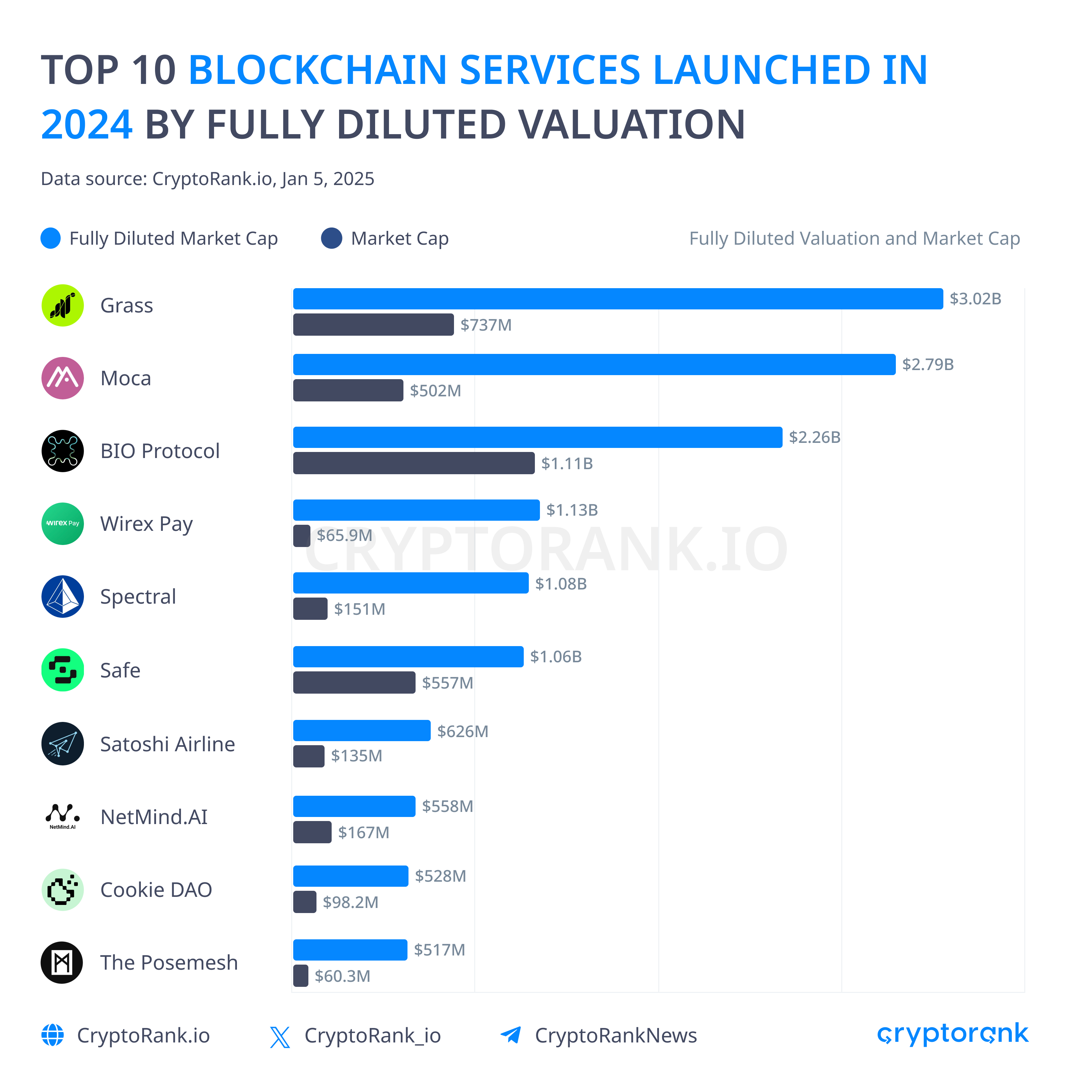
NFTs
While the NFT narrative couldn’t rival the memecoins mania, it successfully adapted to shifting market interests. At the end of the year, NFT trading volumes surged following the announcement of the PENGU token launch by the Pudgy Penguins NFT collection. The PENGU airdrop marked a record-breaking milestone, with approximately 5 million eligible wallets receiving tokens—not only for owning NFTs but also for activity on the Solana and Ethereum networks. This initiative continued the growing trend of NFT collections launching their own tokens, building on the earlier release of the CULT token by Milady. Notably, Doodles and Azuki have announced plans to release their own tokens in the coming year.
In 2022, when NFTs were at the peak of their popularity, the APE token was launched by the Yuga Labs team. This year, ApeChain, a Layer-2 network where APE is used to pay fees, was successfully launched on the mainnet. However, this did not lead to significant growth for the BAYC and MAYC collections, and in 2024, Yuga lost its leading position in the NFT market.
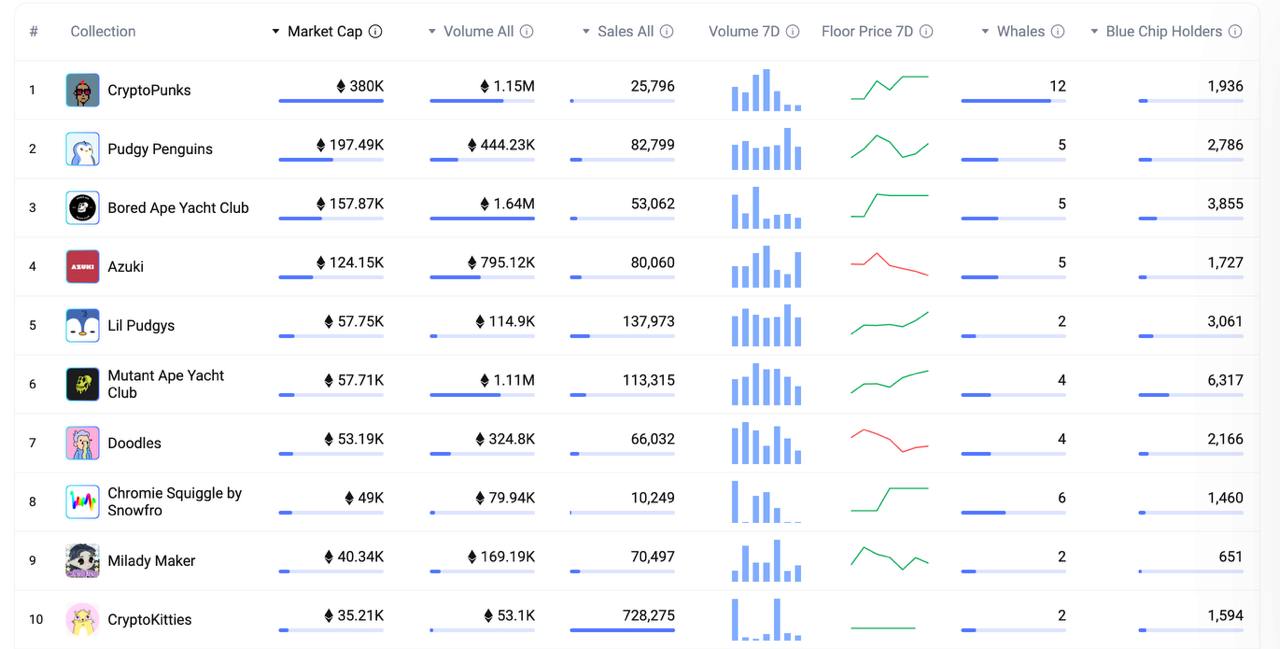
However, the overall NFT market is in stagnation as NFT trading volume and floor prices went down. NFTs now illustrate what happens to a niche when hype fades, and utility remains underdeveloped. This does not mean the sector lacks potential, but its revival will require fundamental changes, including new narratives and innovative utilities.
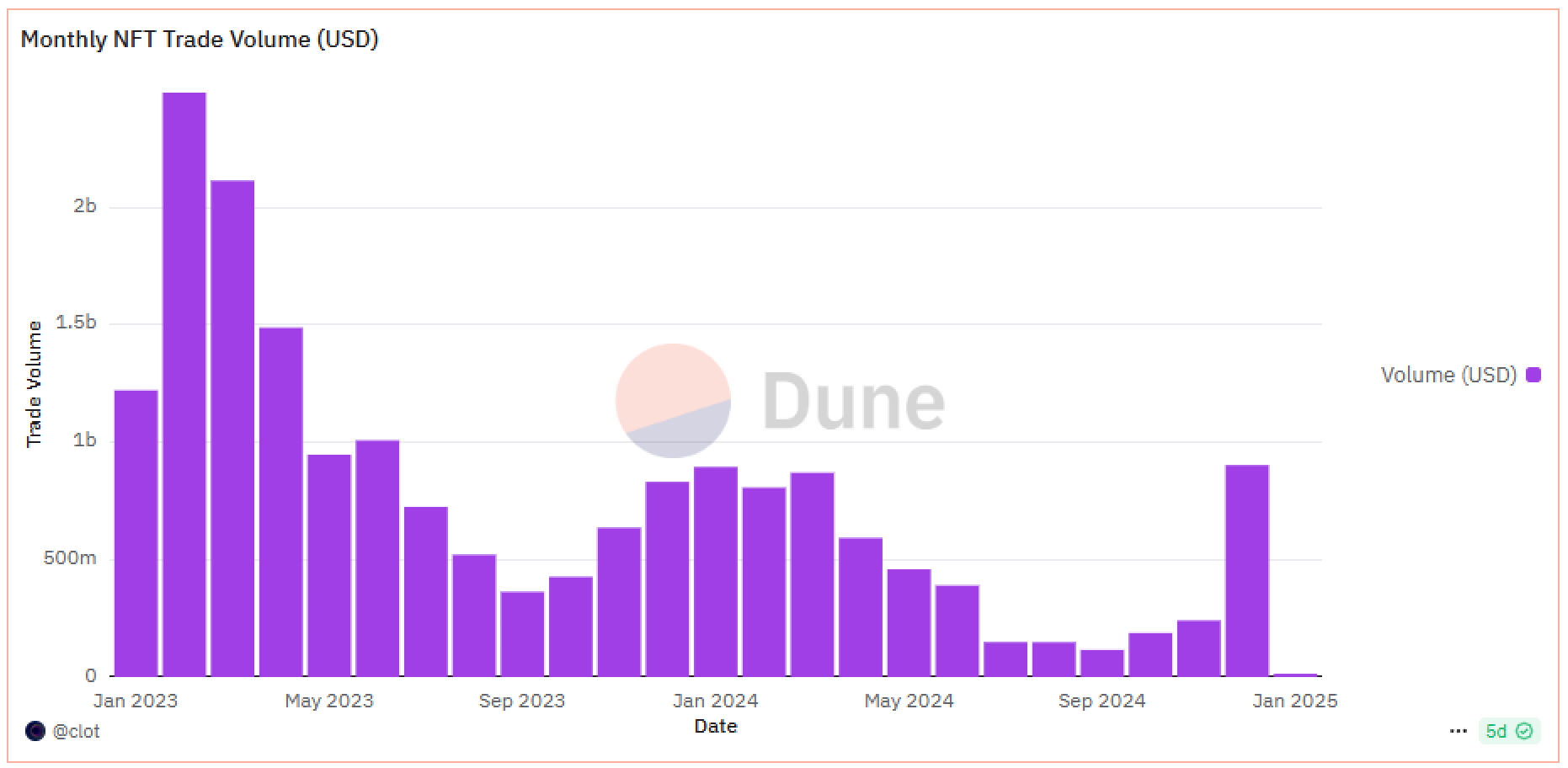
Predictions for 2025
The past year has been marked by numerous historic events, with many optimistic forecasts coming to fruition. Some of the most compelling and well-founded predictions have been made by respected investment funds. We’ve compiled notable forecasts from Bitwise and VanEck over the past year.
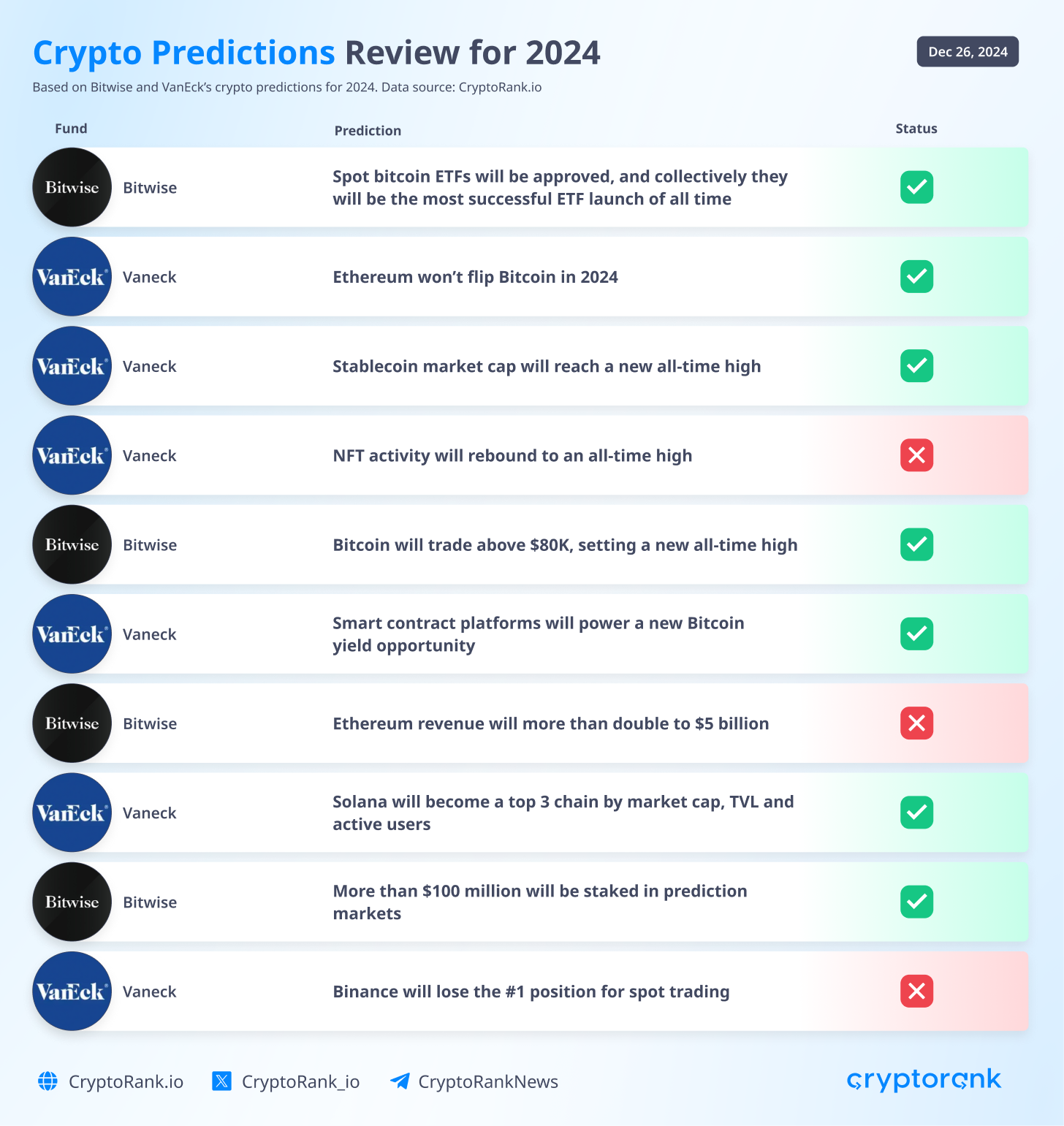
For 2025, both Bitwise and VanEck maintain their optimistic, bullish outlooks. Among the key drivers of growth highlighted in their predictions are the significant influence of AI and pro-crypto policies from the United States.
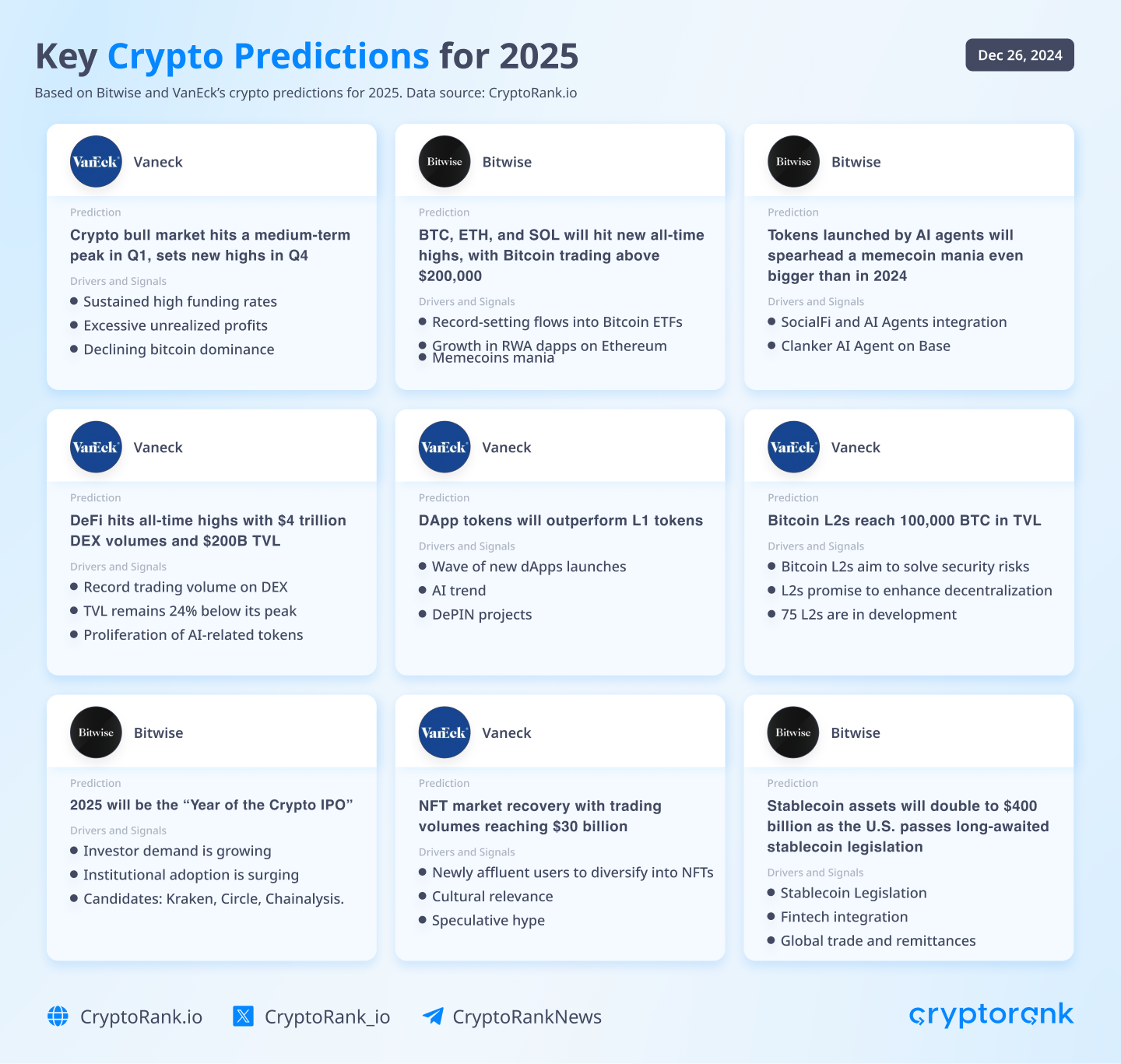
Based on our market insights, we’ve developed our own predictions for 2025:
-
Bitcoin will be adopted as a reserve currency by central banks.
-
A Solana ETF will be launched.
-
Both Bitcoin and Solana will reach new all-time highs in 2025.
-
Bitcoin DeFi will emerge as one of the leading narratives.
-
XRP will drop out of the top 5 cryptocurrencies by market capitalization.
-
An increasing number of S&P 500 companies will hold Bitcoin.
-
A shift toward a bear market will begin in the second half of 2025.
The Bottom Line
The year 2024 was a historic one for the crypto market. Cryptocurrencies have been recognized as a world-class asset, with Bitcoin surpassing the $100,000 mark. Bitcoin could be on the path to becoming a reserve currency, potentially strengthening its position in the crypto space and increasing its market share in 2024.
The altcoin market has also grown, though more in breadth than in price, with new protocols emerging and existing ones being improved. Not all niches have stood the test of time—some remain in a stagnant state despite the ongoing bull market. However, those that provide real utility continue to thrive as top performers.
Looking ahead to 2025, we anticipate many exciting events and projects, and perhaps even a renewal of price highs.
Disclaimer: This post was independently created by the author(s) for general informational purposes and does not necessarily reflect the views of ChainRank Analytics OÜ. The author(s) may hold cryptocurrencies mentioned in this report. This post is not investment advice. Conduct your own research and consult an independent financial, tax, or legal advisor before making any investment decisions. The information here does not constitute an offer or solicitation to buy or sell any financial instrument or participate in any trading strategy. Past performance is no guarantee of future results. Without the prior written consent of CryptoRank, no part of this report may be copied, photocopied, reproduced or redistributed in any form or by any means.
In This Insight
Coins
Table of Contents
- Market Performance in 2024
- Bitcoin
- Analysis of the Top 10 Cryptocurrencies by Market Capitalization
- Top 10 Charts Overview: Key Conclusions & Strength Rankings
- Sector Analysis
- Blockchain Analysis
- DeFi Sector
- Prediction Markets
- Meme Coins
- Blockchain Infrastructure
- GameFi
- Blockchain Services
- NFTs
- Predictions for 2025
- The Bottom Line
Table of Contents
- Market Performance in 2024
- Bitcoin
- Analysis of the Top 10 Cryptocurrencies by Market Capitalization
- Top 10 Charts Overview: Key Conclusions & Strength Rankings
- Sector Analysis
- Blockchain Analysis
- DeFi Sector
- Prediction Markets
- Meme Coins
- Blockchain Infrastructure
- GameFi
- Blockchain Services
- NFTs
- Predictions for 2025
- The Bottom Line